FY2014 Science Highlights
View Highlights from previous years: FY2013 | FY2012 | FY2011
Click on each figure to see a larger version.
Large Grains in the Star-forming Filament OMC-2/3
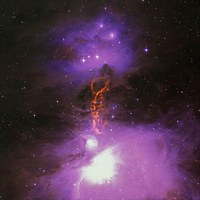 The star-forming material in the Orion molecular cloud complex known as OMC-2/3 is organized into a skein of twisted dust-rich filaments dotted with many dense cores. Thermal continuum emission from the dust can be detected at mm-wavelengths, while the gas temperature in the dense cores has been derived from NH3line ratios measured with the VLAand GBT. Thermal emission from dust is modeled as a modified blackbody spectrum with a frequency dependence given by the power-law slope β, the emissivity spectral index. β varies with location in the interstellar medium and with the stage of a protostar's evolution. In molecular clouds and cloud cores it has a typical value of +1.5 to +2.5.
The star-forming material in the Orion molecular cloud complex known as OMC-2/3 is organized into a skein of twisted dust-rich filaments dotted with many dense cores. Thermal continuum emission from the dust can be detected at mm-wavelengths, while the gas temperature in the dense cores has been derived from NH3line ratios measured with the VLAand GBT. Thermal emission from dust is modeled as a modified blackbody spectrum with a frequency dependence given by the power-law slope β, the emissivity spectral index. β varies with location in the interstellar medium and with the stage of a protostar's evolution. In molecular clouds and cloud cores it has a typical value of +1.5 to +2.5.
Recent measurements in the 3.3 mm continuum using the MUSTANG bolometer array on the GBT by Schnee et al. show that the filaments are significantly brighter than expected and thus imply a low value for β < 1. An index this low has been seen previously only in disks around pre-main sequence stars and brown dwarfs, and has been attributed to emission from dust grains with sizes up to a few mm.
The GBT OMC-2/3 results suggest the presence of large grains or pebbles of at least 1 mm and perhaps as large as 1 cm, in the dense parts of the filament to which the measurements are most sensitive. These grains are much larger than typically found in the diffuse interstellar medium, and this would be the first report of large grains in structures with scales on the order of 1 pc.
Although a power-law spectrum has been used successfully to model dust emission from many different environments, the shallow spectral index between 1 and 3 mm could alternatively indicate that a more complex model is needed for OMC-2/3. In either case, more detailed observations are required to study the full dust spectral energy distrubution in filaments so that the data can be used to make accurate measurements of mass, temperature, and the possible existence of large grains.
Figure: Radio/optical composite of the Orion Molecular Cloud Complex and the OMC-2/3 star-forming filament. Orange: GBT data.
View Paper: Evidence for Large Grains in the Star-forming Filament OMC-2/3, S. Schnee (NRAO), B. Mason (NRAO), J. Di Francesco (NRC-Canada, Victoria), R. Friesen (NRAO, Toronto), D. Li (NAO-Chinese Academy of Science, SSI), S. Sadavoy (MPIfA) & T. Stanke (ESO), 2014, MNRAS, 444, 2303 (1 Nov 2014).
View 27 August 2014 Press Release
Mapping the Laniakea Supercluster
Galaxies congregate in clusters and along filaments, and are missing from large regions known as voids. Spectroscopic surveys reveal networks of interconnected structure that lack clear boundaries. Extended regions with a high concentration of galaxies are called superclusters. There is, however, another way to analyze the structure. If each galaxy distance is directly measured, then the peculiar velocity – the line-of-sight departure from the cosmic expansion that arises from gravitational perturbations – can be derived. A map of peculiar velocities can be translated into a map of matter distribution.
Using galaxy peculiar velocities measured out to a distance of ~100 Mpc, many from the GBT, Tully et al. have created a structure map and identified “gravity sheds”, analogous to “water sheds”, around which velocities diverge. The surface defined by these gravity sheds sets the boundary of local large-scale structure that has separated from the Hubble flow, and hence our home supercluster. The authors find a filamentary lattice that includes the Great Attractor and our previously known supercluster. The region contains 105 galaxies, and a total gravitating mass of 1017 M⊙. The authors have named this filamentary lattice Laniakea, which means “immense heaven” in the Hawaiian language.
Figure: A slice of the Laniakea Supercluster. Colors represent density – red for high densities and blue for voids. The white dots are individual galaxies. Velocity flow streams within the region gravitationally dominated by Laniakea are shown in white, while dark blue flow lines are away from the Laniakea basin of attraction. The orange contour encloses the outer limits of these streams, a diameter of ~160 Mpc. Credit: SDvision software by DP at CEA/Saclay, France.
View Paper: Mapping the Laniakea Supercluster of Galaxies, R. Brent Tully (IfA), Hélène Courtois (Université Lyon I), Yehuda Hoffman (Hebrew), Daniel Pomarède (CEA/Saclay), 2014 Nature, 513, 71 (4 September 2014).
View 3 September 2014 Press Release
Added 6 Feb 2015
Comets Forge Organic Molecules in Their Dusty Atmospheres
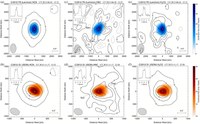 Cordiner et al. present science results from the first cometary observations conducted withALMA, including measurements of the spatially resoled distributions of HCN, HNC, H2CO, and dust within the comae of two comets: C/2012 F6 (Lemmon) and C/2012 S1 (ISON), observed at heliocentric distances of 1.5 and 0.54 AU, respectively. These ALMA data, obtained with 0.5-arcsec angular resolution, reveal an unprecedented level of detail in the distributions of these fundamental cometary molecules, and demonstrate the power of ALMA for quantitative measurements of the distributions of molecules and dust in the inner comae of typical bright comets. In both comets, HCN is found to originate from, or within a few hundred kilometers of, the nucleus, with a spatial distribution largely consistent with spherically symmetric, uniform outflow. By contrast, the HNC distributions are clumpy and asymmetrical, with peaks at cometocentric radii ~500–1000 km, consistent with release of HNC in collimated outflow(s). Compared to HCN, the H2CO distribution in comet Lemmon is very extended. The interferometric visibility amplitudes are consistent with coma production of H2CO and HNC from unidentified precursor material(s) in both comets. Adopting a Haser model, the H2CO parent scale length is found to be a few thousand kilometers in Lemmon and only a few hundred kilometers in ISON, consistent with the destruction of the precursor by photolysis or thermal degradation at a rate that scales in proportion to the solar radiation flux.
Cordiner et al. present science results from the first cometary observations conducted withALMA, including measurements of the spatially resoled distributions of HCN, HNC, H2CO, and dust within the comae of two comets: C/2012 F6 (Lemmon) and C/2012 S1 (ISON), observed at heliocentric distances of 1.5 and 0.54 AU, respectively. These ALMA data, obtained with 0.5-arcsec angular resolution, reveal an unprecedented level of detail in the distributions of these fundamental cometary molecules, and demonstrate the power of ALMA for quantitative measurements of the distributions of molecules and dust in the inner comae of typical bright comets. In both comets, HCN is found to originate from, or within a few hundred kilometers of, the nucleus, with a spatial distribution largely consistent with spherically symmetric, uniform outflow. By contrast, the HNC distributions are clumpy and asymmetrical, with peaks at cometocentric radii ~500–1000 km, consistent with release of HNC in collimated outflow(s). Compared to HCN, the H2CO distribution in comet Lemmon is very extended. The interferometric visibility amplitudes are consistent with coma production of H2CO and HNC from unidentified precursor material(s) in both comets. Adopting a Haser model, the H2CO parent scale length is found to be a few thousand kilometers in Lemmon and only a few hundred kilometers in ISON, consistent with the destruction of the precursor by photolysis or thermal degradation at a rate that scales in proportion to the solar radiation flux.
Figure: Contour maps of spectrally integrated molecular line flux observed in comets F6/Lemmon (top row) and S1/ISON (bottom row). Continuum flux bitmaps are shown for Lemmon (blue) and ISON (orange) with scales (far right). White crosses designate continuum peaks. PSF FWHM and orientations are at lower left (hatched ellipses). Comet illumination phases and sub-solar points (*) are indicated in the upper right of (a) and (b); projected vectors in the direction of the Sun and the dust trail are shown in (c) and (d). Spectra in each panel (upper left) show line flux as a function of cometocentric velocity.
View Paper: Mapping the Release of Volatiles in the Inner Comae of Comets C/2012 F6 (Lemmon) and C/2012 S1 (ISON) Using the Atacama Large Millimeter/Submillimeter Array, M. A. Cordiner (NASA-Goddard, Catholic), A. J. Remijan (NRAO), J. Boissier(IRAM), S. N. Milam (NASA-Goddard), M. J. Mumma (NASA-Goddard), S. B. Charnley (NASA-Goddard), L. Paganini (NASA-Goddard, Catholic), G. Villanueva (NASA-Goddard, Catholic), D. Bockelée-Morvan (Paris), Y.-J. Kuan (National Taiwan Normal, ASIAA), Y.-L. Chuang (National Taiwan Normal), D. C. Lis (Paris, Caltech), N. Biver (Paris), J. Crovisier (Paris), D. Minniti (Catolica, Andres Bello), and I. M. Coulson (JAC), 2014 ApJ Letters, 792, L2 (1 September 2014).
Added 6 Feb 2015
An Accurate, Precise Pleiades Distance Measurement
 The Pleiades hold an important place in our understanding of stellar evolution. Its hundreds of young stars help to define the zero-age main sequence, and serve as templates for determining the physical characteristics of more distant stars. Because many derived physical properties of stars depend on their distance raised to some power, the distance to the Pleiades is an important measurement whose accuracy propagates throughout modern stellar physics.
The Pleiades hold an important place in our understanding of stellar evolution. Its hundreds of young stars help to define the zero-age main sequence, and serve as templates for determining the physical characteristics of more distant stars. Because many derived physical properties of stars depend on their distance raised to some power, the distance to the Pleiades is an important measurement whose accuracy propagates throughout modern stellar physics.
It was of some concern, therefore, when results from the Hipparcos astrometric satellite suggested that the traditional distance to the Pleiades – about 135 pc via multiple techniques – was 10% too high and that the cluster was located only 120 pc away. At the closer distance some stars in the Pleiades would be decidedly peculiar, possibly implying enhanced helium abundances and hinting of serious flaws in our understanding of fundamental stellar evolution.
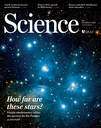 To resolve the issue a research team led by Carl Melis (UC, San Diego) undertook a campaign of precise radio astrometry on several Pleiades stars that are weak radio sources and measured their annual stellar parallax with respect to a background quasar over ~18 months. Because of the weakness of the radio signal, a telescope network was used that included the VLBA, GBT, Arecibo and Effelsberg. The resultant distances to four stars had uncertainties of 0.5 to 1.1 pc and this a 99+% precision in the measured distance. After taking into account that the stars are likely at different depths in the cluster, an effect estimated from the cluster's angular size, the very long baseline interferometry measurements yield a distance for the combined sample of 136.2 ±1.2 pc. This is the most accurate and precise distance measurement for the Pleiades, and is compatible with most previous measurements, except for the Hipparcossatellite.
To resolve the issue a research team led by Carl Melis (UC, San Diego) undertook a campaign of precise radio astrometry on several Pleiades stars that are weak radio sources and measured their annual stellar parallax with respect to a background quasar over ~18 months. Because of the weakness of the radio signal, a telescope network was used that included the VLBA, GBT, Arecibo and Effelsberg. The resultant distances to four stars had uncertainties of 0.5 to 1.1 pc and this a 99+% precision in the measured distance. After taking into account that the stars are likely at different depths in the cluster, an effect estimated from the cluster's angular size, the very long baseline interferometry measurements yield a distance for the combined sample of 136.2 ±1.2 pc. This is the most accurate and precise distance measurement for the Pleiades, and is compatible with most previous measurements, except for the Hipparcossatellite.
Figure: A summary of the distance measurements. It is now of considerable interest to understand the source of the systematic error in the Hipparcos results, as the astrometric satellite Gaia, a successor to Hipparcos with considerably enhanced capabilities, has similarities of design and data analysis, and is now mapping the Milky Way.
View Paper: Toward a VLBI resolution of the Pleiades distance controversy, Melis, C., Reid, M.J., Mioduszewski, A.J., Stauffer, J.R., Bower, G.C. 2014, Science, 345, 1029 (29 August 2014).
View 28 August 2014 Press Release
Added 02 October 2014
A Lensed Major Merger
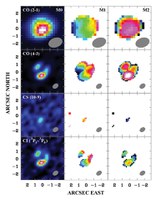 The submillimeter-bright galaxy population is believed to comprise intrinsically active star-forming galaxies, the brightest of which are lensed gravitationally. Messias et al. have focused on one of these lensed systems from the Herschel-ATLAS field: HATLAS J142935.3−002836. Their multi-wavelength dataset, including ALMA observations, is used to confirm the lensing hypothesis, model the background source morphology and dynamics, and enable a detailed physical characterization. A lensing-analysis algorithm that simultaneously fits different wavebands is adopted to characterize the lens. The background galaxy dynamical information is studied by reconstructing the 3D source plane of the ALMA CO (J 4-3) transition. Near-infrared imaging from the Hubble Space Telescope and the Keck Observatory allows the authors to constrain rest-frame optical photometry independently for the foreground and background systems. Physical parameters are estimated via spectral energy distribution modeling. The authors determined that the system comprises a foreground edge-on disk galaxy at z = 0.218 with a near-complete Einstein ring surrounding it. The background source at z = 1.027 is magnified by a factor of μ ~ 8−10 depending on wavelength and is comprised of two components and a tens-of-kpc-long tidal tail resembling the well-studied NGC 4038/4039 Antennae merger. The background source is a massive stellar system of 1.32 x 1011 M⊙ forming stars at a rate of 394 ± 90 M⊙ yr-1, and it has a significant gas reservoir of 4.6 ± 1.7 x 1010 M⊙. Its depletion time due to star formation is thus expected to be τSF = MISM/ SFR = 117 ± 51 Myr. The dynamical mass of one of the components is 5.8 ± 1.7 × 1010 M⊙, and, together with the photometric total mass, implies that H1429−0028 is a major merger system.
The submillimeter-bright galaxy population is believed to comprise intrinsically active star-forming galaxies, the brightest of which are lensed gravitationally. Messias et al. have focused on one of these lensed systems from the Herschel-ATLAS field: HATLAS J142935.3−002836. Their multi-wavelength dataset, including ALMA observations, is used to confirm the lensing hypothesis, model the background source morphology and dynamics, and enable a detailed physical characterization. A lensing-analysis algorithm that simultaneously fits different wavebands is adopted to characterize the lens. The background galaxy dynamical information is studied by reconstructing the 3D source plane of the ALMA CO (J 4-3) transition. Near-infrared imaging from the Hubble Space Telescope and the Keck Observatory allows the authors to constrain rest-frame optical photometry independently for the foreground and background systems. Physical parameters are estimated via spectral energy distribution modeling. The authors determined that the system comprises a foreground edge-on disk galaxy at z = 0.218 with a near-complete Einstein ring surrounding it. The background source at z = 1.027 is magnified by a factor of μ ~ 8−10 depending on wavelength and is comprised of two components and a tens-of-kpc-long tidal tail resembling the well-studied NGC 4038/4039 Antennae merger. The background source is a massive stellar system of 1.32 x 1011 M⊙ forming stars at a rate of 394 ± 90 M⊙ yr-1, and it has a significant gas reservoir of 4.6 ± 1.7 x 1010 M⊙. Its depletion time due to star formation is thus expected to be τSF = MISM/ SFR = 117 ± 51 Myr. The dynamical mass of one of the components is 5.8 ± 1.7 × 1010 M⊙, and, together with the photometric total mass, implies that H1429−0028 is a major merger system.
Figure: Moment maps and line profiles of the emission lines detected in H1429−0028 as observed by ALMA: CO(2 -1) on the top row; CO(4-3) on the second row; CS(10-9) on the third row; [CI 3P1-3P0] on the bottom row. The columns show different image moments: moment-0 (M0, velocity-integrated flux, left), moment-1 (M1, velocity map, middle), and moment-2 (M2, dispersion map, right). The beam is at lower right in each panel. Axes units are arcseconds. Color scales of M0 are from −0.3 to 8 (first row), 18 (second), 2 (third), 5 Jy km s-1 (fourth). Color scales in M1 and M2 are, respectively, −200 to 200 and 0 to 170 km s-1.
View Paper: Herschel-ATLAS and ALMA: HATLAS J142935.3-002836, a Lensed Major Merger at Redshift 1.027, Hugo Messias (Concepción, Lisboa), Simon Dye (Nottingham), Neil Nagar (Concepción), Gustavo Orellana (Concepción), R. Shane Bussmann (CfA), Jae Calanog (UC-Irvine), Helmut Dannerbauer (Wien), Hai Fu (Iowa), Edo Ibar (Valparaíso), Andrew Inohara (UC-Irvine), R. J. Ivison (Edinburgh, ESO), Mattia Negrello (INAF), Dominik A. Riechers (Caltech, Cornell), Yun-Kyeong Sheen (Concepción), James E. Aguirre (Penn), Simon Amber (Open), Mark Birkinshaw (Bristol, CfA), Nathan Bourne (Nottingham), Charles M. Bradford (JPL), Dave L. Clements (Imperial College London), Asantha Cooray (UC-Irvine, Caltech), Gianfranco De Zotti (INAF), Ricardo Demarco (Concepción), Loretta Dunne (Canterbury, Edinburgh), Stephen Eales (Cardiff), Simone Fleuren (London), Julia Kamenetzky (UC-Boulder), Roxana E. Lupu (Penn), Steve J. Maddox (Canterbury, Edinburgh), Daniel P. Marrone (Arizona), Michał J. Michałowski (Edinburgh), Eric J. Murphy (Caltech), Hien T. Nguyen (JPL), Alain Omont (Paris), Kate Rowlands (St. Andrews), Dan Smith (Hertfordshire), Matt Smith (Cardiff), Elisabetta Valiante (Cardiff), and Joaquin D. Vieira (Illinois), 2014 A&A, 568, A92 (26 August 2014).
Added 6 Feb 2015
Misaligned Disks in a Young Binary System
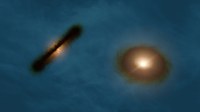 Many extrasolar planets follow orbits that differ from the nearly coplanar and circular orbits found in our Solar System. Extrasolar planet orbits may be eccentric or inclined with respect to the host star’s equator, and the population of giant planets orbiting close to their host stars suggests appreciable orbital migration. There is no consensus regarding what produces such orbits. Theoretical explanations often invoke interactions with a binary companion star in an orbit that is inclined relative to the planet’s orbital plane. Such mechanisms require significant mutual inclinations between the planetary and binary star orbital planes. The protoplanetary disks in a few young binaries are misaligned, but often the measurements of these misalignments are sensitive only to a small portion of the inner disk, and the three-dimensional misalignment of the bulk of the planet-forming disk mass has hitherto not been determined. Based on mm-wave observations of the young binary system HK Tauri with ALMA, Jensen and Akeson report that the protoplanetary disks in this system are misaligned by 60 to 68 deg, such that one or both of the disks are significantly inclined to the binary orbital plane. Their results demonstrate that the necessary conditions exist for misalignment-driven mechanisms to modify planetary orbits, and that these conditions are present at the time of planet formation, apparently because of the binary formation process.
Many extrasolar planets follow orbits that differ from the nearly coplanar and circular orbits found in our Solar System. Extrasolar planet orbits may be eccentric or inclined with respect to the host star’s equator, and the population of giant planets orbiting close to their host stars suggests appreciable orbital migration. There is no consensus regarding what produces such orbits. Theoretical explanations often invoke interactions with a binary companion star in an orbit that is inclined relative to the planet’s orbital plane. Such mechanisms require significant mutual inclinations between the planetary and binary star orbital planes. The protoplanetary disks in a few young binaries are misaligned, but often the measurements of these misalignments are sensitive only to a small portion of the inner disk, and the three-dimensional misalignment of the bulk of the planet-forming disk mass has hitherto not been determined. Based on mm-wave observations of the young binary system HK Tauri with ALMA, Jensen and Akeson report that the protoplanetary disks in this system are misaligned by 60 to 68 deg, such that one or both of the disks are significantly inclined to the binary orbital plane. Their results demonstrate that the necessary conditions exist for misalignment-driven mechanisms to modify planetary orbits, and that these conditions are present at the time of planet formation, apparently because of the binary formation process.
Figure: Artist's impression of the misaligned protoplanetary disks around the binary stars in HK Tau. Credit: R. Hurt (NASA/JPL-Caltech/IPAC)
View Paper: Misaligned Protoplanetary Disks in a Young Binary Star System, Eric L.N. Jensen (Swarthmore) and Rachel Akeson (IPAC/Caltech), 2014 Nature, 511, 567 (31 July 2014).
View 30 July 2014 Press Release
The Chemistry of the Dense Molecular Gas in NGC 1068
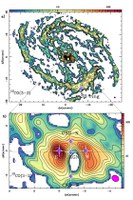 Viti et al. present a detailed analysis of ALMA Band 7 and 9 imaging of multiple molecular lines – CO, HCO+, HCN, CS – and dust in the ~200 pc circum-nuclear disk and the ~1.3 kpc starburst ring of NGC 1068, a nearby (d = 14 Mpc) Seyfert 2 barred galaxy. The circum-nuclear disk is very dense (ρ > 105cm-3) and hot (T > 150K). The Active Galactic Nucleus in NGC 1068 has the highest densities, indicated by the CO to HCO+, HCN, and CS ratios. The starburst ring is much colder and less dense than the circum-nuclear disk. Chemical modeling does not succeed in reproducing all the molecular ratios with one model per region, suggesting the presence of multi-gas phase components.
Viti et al. present a detailed analysis of ALMA Band 7 and 9 imaging of multiple molecular lines – CO, HCO+, HCN, CS – and dust in the ~200 pc circum-nuclear disk and the ~1.3 kpc starburst ring of NGC 1068, a nearby (d = 14 Mpc) Seyfert 2 barred galaxy. The circum-nuclear disk is very dense (ρ > 105cm-3) and hot (T > 150K). The Active Galactic Nucleus in NGC 1068 has the highest densities, indicated by the CO to HCO+, HCN, and CS ratios. The starburst ring is much colder and less dense than the circum-nuclear disk. Chemical modeling does not succeed in reproducing all the molecular ratios with one model per region, suggesting the presence of multi-gas phase components.
Figure: ALMA CO 3-2 image of the starburst ring and circum-nuclear disk in NGC 1068.
View Paper: Molecular line emission in NGC1068 imaged with ALMA: II. The chemistry of the dense molecular gas, S. Viti (UCL), S. Garcia-Burillo (OAN-Madrid), A. Fuente (OAN-Madrid), L.K. Hunt (INAF), A. Usero (OAN-Madrid), C. Henkel (MPIfR, King Abdulaziz), A. Eckart (Kln, MPIfR), S. Martin (IRAM), M. Spaans (Groningen), S. Muller (Onsala), F. Combes (Paris), M. Krips (IRAM), E. Schinnerer (MPIfA), V. Casasola (INAF), F. Costagliola (CSIC), I. Marquez (CSIC), P. Planesas (OAN-Madrid), P.P. van der Werf (Leiden), S. Aalto (Onsala), A.J. Baker (Rutgers), F. Boone (Toulouse), and L.J. Tacconi (MPIfEP), 2014 A&A, 567, A125 (July 2014).
Imaging Extragalactic Gas
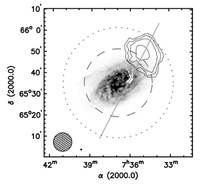 Observed HI accretion around nearby galaxies can only account for a fraction of the gas supply needed to sustain the currently observed star formation rates. It is possible that additional accretion happens in the form of low column density cold flows, as predicted by numerical simulations of galaxy formation. To constrain the presence and properties of such flows, de Blok et al. present deep HI observations obtained with the GBT of a 4 x 4 deg area around NGC 2403. These observations, with a 5σ detection limit of 2.4 x 1018 cm-2 over a 20 km/s linewidth, reveal the presence of a low-column density, extended cloud outside the main HI disk, about 17 arcmin (~16 kpc) to the NW of the center of the galaxy. The total HI mass of the cloud is 6.3 x 106 M☉, or 0.15 percent of the total HI mass of NGC 2403. The cloud is associated with an 8 kpc anomalous-velocity HI filament in the inner disk, previously observed in deep VLA observations by Fraternali et al. (2001, 2002). The authors discuss several scenarios for the origin of the cloud, and conclude that it is either accreting from the intergalactic medium, or is the result of a minor interaction with a neighbouring dwarf galaxy.
Observed HI accretion around nearby galaxies can only account for a fraction of the gas supply needed to sustain the currently observed star formation rates. It is possible that additional accretion happens in the form of low column density cold flows, as predicted by numerical simulations of galaxy formation. To constrain the presence and properties of such flows, de Blok et al. present deep HI observations obtained with the GBT of a 4 x 4 deg area around NGC 2403. These observations, with a 5σ detection limit of 2.4 x 1018 cm-2 over a 20 km/s linewidth, reveal the presence of a low-column density, extended cloud outside the main HI disk, about 17 arcmin (~16 kpc) to the NW of the center of the galaxy. The total HI mass of the cloud is 6.3 x 106 M☉, or 0.15 percent of the total HI mass of NGC 2403. The cloud is associated with an 8 kpc anomalous-velocity HI filament in the inner disk, previously observed in deep VLA observations by Fraternali et al. (2001, 2002). The authors discuss several scenarios for the origin of the cloud, and conclude that it is either accreting from the intergalactic medium, or is the result of a minor interaction with a neighbouring dwarf galaxy.
Figure: The field around NGC 2403 showing the HI cloud found by the GBT.
View Paper: A low HI Column Density Filament in NGC 2403: Signature of Interaction or Accretion, W.J.G. de Blok (ASTRON, Cape Town, Groningen), Katie M. Keating (Rincon), D.J. Pisano (NRAO, WVU), F. Fraternali (Bologna, Groningen), F. Walter (MPIfA), T. Oosterloo (ASTRON, Groningen), E. Brinks (Hertfordshire), F. Bigiel (Heidelberg), A. Leroy (NRAO), 2014 A&A, 569, A68 (September 2014).
Revealing Protoplanetary Disk Dynamics and Chemistry
To better understand the structure of the inner regions of protostars and the interplay between the chemistry and the presence of disks, Lindberg et al. have employed ALMA to acquire high-resolution images of Class 0/I Young Stellar Objects (YSOs) and protoplanetary disks in the R CrA cloud. In IRS7B, the C17O emission shows a rotation curve consistent with a Keplerian disc with a well-defined edge at 50 AU. The central YSO mass is 2.3 M⊙ and the protoplanetary disk mass is 0.024 M⊙. The authors propose that the regions of the envelopes where complex organic molecules are present in Class 0/1 YSOs can become quenched as the disk grows.
Figure: Dust continuum emission from Class 0/1 YSOs at 342 GHz. [Inset, Lower Left] C17O gas dynamics in IRS7B.
View Paper: ALMA Observations of the Kinematics and Chemistry of Disc Formation, Johan E. Lindberg (Niels Bohr Institute, Copenhagen), Jes K. Jørgensen (Copenhagen, Niels Bohr Institute), Christian Brinch (Copenhagen, Niels Bohr Institute), Troels Haugbølle (Niels Bohr Institute, Copenhagen), Edwin A. Bergin (Michigan), Daniel Harsono (Leiden, SRON), Magnus V. Persson (Leiden), Ruud Visser (Michigan), and Satoshi Yamamoto (Tokyo), 2014 A&A, 566, A74 (June 2014)
Added 23 July 2014
Imaging the Dynamics of Normal Galaxy Formation
ALMA has imaged the [CII] 158μm emission from a group of normal Lyman-break galaxies at z=5.3. The gas dynamics shows clear signs of gravitational interaction driving star formation in the galaxies. Interestingly, the system is not detected in the dust continuum, with an implied upper limit to the star formation rate of < 50 M⊙/year. The [CII] 158μm line is fulfilling its potential as a unique tracer of early galaxy dynamics and as a redshift indicator, even for galaxies without extreme starbursts.
Figure: [Top] The [CII] 158μm emission from the z=5.3 Lyman-break galaxy group in the Cosmic Evolution Survey (COSMOS) field in total intensity and velocity. [Bottom] Sample ALMA spectra.
View Paper: ALMA Imaging of Gas and Dust in a Galaxy Protocluster at Redshift 5.3,Dominik A. Riechers (Cornell), Christopher L. Carilli (NRAO), Peter L. Capak (IPAC), Nicholas Z. Scoville (Caltech), Vernesa Smolcic (Caltech), Eva Schinnerer (MPIfA), Min Yun (Massachusetts), Pierre Cox (ALMA), Frank Bertoldi (Bonn), Alexander Karim (Bonn), Lin Yan (IPAC), 2014 ApJ, 796, 84 (1 December 2014).
Imaging Massive Star-forming Disk Galaxies
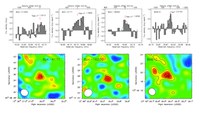 VLA observations have shown that typical star-forming galaxies contain massive reservoirs of cool molecular gas during the peak epoch of cosmic star formation (z ~ 1 to 3). The gas to stellar mass ratio changes from 0.1 in nearby disk galaxies, to > 1.0 at z ~ 2. This order of magnitude increase in the molecular baryon fraction like drives the increased cosmic star formation rate during the epoch of galaxy assembly. In this paper, the authors present detections of the CO(1–0) emission line with the VLA in a sample of four massive star-forming galaxies at z ∼ 1.5 – 2.2. Combining these data with previous CO(2–1) and CO(3–2) detections of these galaxies, the authors study the excitation properties of the molecular gas in their sample sources, finding an average line brightness temperature ratios of R21 = 0.70 ± 0.16 and R31 = 0.50 ± 0.29. These results provide additional support to previous indications of sub-thermal gas excitation for the CO(3–2) line with a typically assumed line ratio R31 ∼ 0.5. For the galaxy BzK-21000, the authors present spatially resolved CO line maps. At a resolution of 0.18 arcsec (1.5 kpc), most of the emission is resolved out except for some clumpy structure. From this, the authors attempt to identify molecular gas clumps in the data cube, finding four possible candidates. They estimate that < 40% of the molecular gas is confined to giant clumps (∼1.5 kpc in size) and, thus, most of the gas could be distributed in small fainter clouds or in fairly diffuse extended regions of lower brightness temperatures than our sensitivity limit.
VLA observations have shown that typical star-forming galaxies contain massive reservoirs of cool molecular gas during the peak epoch of cosmic star formation (z ~ 1 to 3). The gas to stellar mass ratio changes from 0.1 in nearby disk galaxies, to > 1.0 at z ~ 2. This order of magnitude increase in the molecular baryon fraction like drives the increased cosmic star formation rate during the epoch of galaxy assembly. In this paper, the authors present detections of the CO(1–0) emission line with the VLA in a sample of four massive star-forming galaxies at z ∼ 1.5 – 2.2. Combining these data with previous CO(2–1) and CO(3–2) detections of these galaxies, the authors study the excitation properties of the molecular gas in their sample sources, finding an average line brightness temperature ratios of R21 = 0.70 ± 0.16 and R31 = 0.50 ± 0.29. These results provide additional support to previous indications of sub-thermal gas excitation for the CO(3–2) line with a typically assumed line ratio R31 ∼ 0.5. For the galaxy BzK-21000, the authors present spatially resolved CO line maps. At a resolution of 0.18 arcsec (1.5 kpc), most of the emission is resolved out except for some clumpy structure. From this, the authors attempt to identify molecular gas clumps in the data cube, finding four possible candidates. They estimate that < 40% of the molecular gas is confined to giant clumps (∼1.5 kpc in size) and, thus, most of the gas could be distributed in small fainter clouds or in fairly diffuse extended regions of lower brightness temperatures than our sensitivity limit.
Figure: CO(1–0) spectra obtained for the four targets. The BzK-21000 spectra were obtained in a circular 2 arcsec aperture enclosing most of the CO emission. The spectral resolution is ∼50 km/sec for BzK-21000, ∼60 km/sec for BX610, and ∼80 km/secfor BzK-4171 and BzK-16000. The red arrows indicate the frequency of the CO(1–0) line based on the previously determined CO(2–1) redshift (Daddi et al. 2010a). For BX610, the red arrow shows the frequency of the CO(1–0) line using the optical redshift (Erb et al. 2006; Förster Schreiber et al. 2009, 2011).
View Paper: CO(1-0) Line Imaging of Massive Star-forming Disc Galaxies at z = 1.5-2.2, M. Aravena (Diego Portales, ESO), J.A. Hodge (NRAO), J. Wagg (SKA), C.L. Carilli (NRAO, Cambridge), E. Daddi (CEA), H. Dannerbauer (Wien), L. Lentati (Cambridge), D.A. Riechers (Cornell), M. Sargent (Sussex), and F. Walter (MPIfA), 2014 MNRAS, 442, 558 (21 July 2014).
Added 6 Feb 2015
The Intrinsic Size of Sgr A*
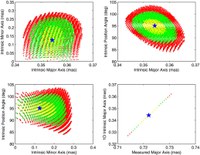 Bower et al. have used the VLBA at a wavelength of 7mm to make the best measurement to date of the intrinsic size and two-dimensional structure of the radio source associated with the Galactic Center black hole, SgrA*. The intrinsic source is modeled as an elliptical Gaussian with major x minor axis size of 35.4 x 12.6 RS in position angle 95 deg East of North. This morphology can be interpreted in the context of both jet and accretion disk models for the radio emission. The authors have also placed a maximum peak-to-peak change of 15% in the intrinsic major axis size over five different epochs. Three observations were triggered by detection of near infrared (NIR) flares and one was simultaneous with a large X-ray flare detected by NuSTAR. The absence of simultaneous and quasi-simultaneous flares indicates that not all high-energy events produce variability at radio wavelengths. This supports the conclusion that NIR and X-ray flares are primarily due to electron excitation and not to an enhanced accretion rate onto the black hole.
Bower et al. have used the VLBA at a wavelength of 7mm to make the best measurement to date of the intrinsic size and two-dimensional structure of the radio source associated with the Galactic Center black hole, SgrA*. The intrinsic source is modeled as an elliptical Gaussian with major x minor axis size of 35.4 x 12.6 RS in position angle 95 deg East of North. This morphology can be interpreted in the context of both jet and accretion disk models for the radio emission. The authors have also placed a maximum peak-to-peak change of 15% in the intrinsic major axis size over five different epochs. Three observations were triggered by detection of near infrared (NIR) flares and one was simultaneous with a large X-ray flare detected by NuSTAR. The absence of simultaneous and quasi-simultaneous flares indicates that not all high-energy events produce variability at radio wavelengths. This supports the conclusion that NIR and X-ray flares are primarily due to electron excitation and not to an enhanced accretion rate onto the black hole.
Figure: Two-dimensional and one-dimensional intrinsic size estimates for Sgr A*. Two-dimensional solutions were obtained through deconvolution of all apparent sizes with the two-dimensional scattering size within the 3σ error surface. Colors show solutions that are <1σ (yellow), between 1 and 2σ (green), and between 2 and 3σ (red). Slices through the parameter space at the position of the best-fit position angle, minor axis, and major axis are shown (upper left, upper right, and lower left, respectively). The blue star indicates the best-fit size. The lower right panel illustrates the intrinsic size determined using only the measured major axis size. The same color-coding applies to this panel. The plots show that the maximum intrinsic minor-axis value never reaches the minimum permitted value for the major axis; that is, the intrinsic source must be elliptical.
View Publication: The Intrinsic Two-Dimensional Size of Sagittarius A*, Geoffrey C. Bower (Berkeley, ASIAA), Sera Markoff (Amsterdam), Andreas Brunthaler (MPIfR), Casey Law (Berkeley), Heino Falcke (MPIfR, Radboud, ASTRON), Dipankar Maitra (Wheaton), M. Clavel (Paris, CEA Saclay), A. Goldwurm (Paris, CEA Saclay), M.R. Morris (UCLA), Gunther Witzel (UCLA), Leo Meyer (UCLA), and A.M. Ghez (UCLA), 2014 ApJ, 790, 1 (20 July 2014).
The Coolest White Dwarf
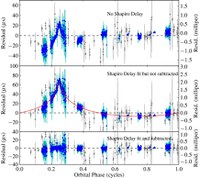 The recycled pulsar PSR J2222-0137 is one of the nearest known neutron stars, with a parallax distance of 267 parsecs and an edge-on orbit. Kaplan et al. measured the Shapiro delay in the system via pulsar timing with the GBT, deriving a low pulsar mass (1.20 ± 0.14 M⊙) and a high companion mass (1.05 ± 0.06 M⊙) consistent with either a low-mass neutron star or a high-mass white dwarf. The neutron star hypothesis is rejected largely on the basis of the system’s extremely low eccentricity (3 x 10-4), too low to have been the product of two supernovae under normal circumstances. However, no optical counterpart of the system was detected despite deep optical and near-IR searches with the SOAR and Keck telescopes. This is consistent with the white dwarf hypothesis only if the effective temperature is <3,000K, a limit that is robust to distance, mass, and atmosphere uncertainties. This would make the companion to PSR J2222-0137 one of the coolest white dwarfs ever observed. For the implied age to be consistent with the age of the Milky Way requires the white dwarf to have already crystallized and entered the faster Debye-cooling regime.
The recycled pulsar PSR J2222-0137 is one of the nearest known neutron stars, with a parallax distance of 267 parsecs and an edge-on orbit. Kaplan et al. measured the Shapiro delay in the system via pulsar timing with the GBT, deriving a low pulsar mass (1.20 ± 0.14 M⊙) and a high companion mass (1.05 ± 0.06 M⊙) consistent with either a low-mass neutron star or a high-mass white dwarf. The neutron star hypothesis is rejected largely on the basis of the system’s extremely low eccentricity (3 x 10-4), too low to have been the product of two supernovae under normal circumstances. However, no optical counterpart of the system was detected despite deep optical and near-IR searches with the SOAR and Keck telescopes. This is consistent with the white dwarf hypothesis only if the effective temperature is <3,000K, a limit that is robust to distance, mass, and atmosphere uncertainties. This would make the companion to PSR J2222-0137 one of the coolest white dwarfs ever observed. For the implied age to be consistent with the age of the Milky Way requires the white dwarf to have already crystallized and entered the faster Debye-cooling regime.
Figure: PSR J2222 timing residuals, including these new (blue) and older data (gray), as a function of orbital phase (true anomaly plus longitude of periastron). [Top] Residuals computed from the best-fit model without Shapiro delay. [Middle]Residuals computed including Shapiro delay. The red curve is the best-fit Shapiro delay profile. [Bottom]Residuals computed relative to the best-fit model including Shapiro delay. The left axis shows the residuals in micro-seconds; the right axis shows the residuals in milli-periods.
View Paper: A 1.0M⊙ Companion to PSR J2222-0137: The Coolest Known White Dwarf, David L. Kaplan (Wisconsin-Milwaukee), Jason Boyles (WVU, WKU), Bart H. Dunlap (North Carolina), Shriharsh P. Tendulkar (Caltech), Adams T. Deller (ASTRON), Scott M. Ransom (NRAO), Maura A. McLaughlin (WVU, NRAO), and Duncan R. Lorimer (WVU, NRAO), 2014 ApJ, 789, 119 (10 July 2014).
View 23 June 2014 Press Release
Added 23 July 2014
High Frequency, High Resolution ALMA Observations as a Probe for AGN Activity in Arp 220
 Christine Wilson (McMaster) and her collaborators have made use of new ALMA high-resolution (~ 0.3") 691 GHz continuum observations of the galaxy merger Arp 220 to address the starburst/AGN nature of its embedded nuclei. Arp 220 is the nearest of a class of ultra-luminous infrared galaxies which have infrared luminosities LIR[8-1000 μm] ≥ 1012 L(sun) that rival the bolometric luminosities of quasi-stellar objects (QSOs). The two nuclei are observed to be the dominant components of the 691GHz emission (see figure).
Christine Wilson (McMaster) and her collaborators have made use of new ALMA high-resolution (~ 0.3") 691 GHz continuum observations of the galaxy merger Arp 220 to address the starburst/AGN nature of its embedded nuclei. Arp 220 is the nearest of a class of ultra-luminous infrared galaxies which have infrared luminosities LIR[8-1000 μm] ≥ 1012 L(sun) that rival the bolometric luminosities of quasi-stellar objects (QSOs). The two nuclei are observed to be the dominant components of the 691GHz emission (see figure).
The authors use the deconvolved sizes of the nuclei to estimate their brightness temperatures, then to ultimately estimate their thermal dust temperatures and optical depths. Both nuclei together are estimated from the dust temperatures and disk extents to account for most or all of the infrared luminosity of Arp 220. The western nucleus is shown to have a very high dust temperature (~200K) and to be optically thick, with τ(434μm) = 5.3. Its derived luminosity surface density of ~1014 L(sun)/kpc2 exceeds the dust Eddington limit in which radiation pressure on dust grains in optically thick environments is the dominant feedback against the disk's self-gravity. While this evidence tentatively points to the western nucleus being host to a luminous AGN, similarly derived properties for the eastern nucleus are well within the range of starbursts-only models. The authors conclude by noting that future ALMA observations of Arp 220 with longer baselines will allow the luminosity surface density to be better constrained, and thus the assessment of the presence of a luminous AGN to be more definitive.
View Publication: Extreme Dust Disks in Arp 220 as Revealed by ALMA, C.D. Wilson (McMaster), N. Rangwala (Colorado), J. Glenn (Colorado), P.R. Maloney (Colorado), L. Spinoglio (INAF-IAPS), M. Pereira-Santaella (INAF-IAPS), 2014 ApJ Letters, 789, L36 (10 July 2014).
View 23 June 2014 Press Release
First Thermal Radio Emission Detection from Solar-type Atmospheres
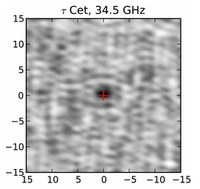 Villadsen et al. present the first detections of thermal radio emission from the atmospheres of the solar-type stars τ Cet, η Cas A, and 40 Eri A. These stars all resemble the Sun in age and level of magnetic activity, as indicated by X-ray luminosity and chromospheric emission in Ca II H and K lines. These stars were observed with the VLA with sensitivities of a few μJy at combinations of 10.0, 15.0, and 34.5 GHz. τ Cet, η Cas A, and 40 Eri A were all detected at 34.5 GHz with signal-to-noise ratios of 6.5, 5.2, and 4.5, respectively. The observed 15.0 GHz upper limits imply a rising spectral index greater than 1.0 for τ Cet and 1.6 for η Cas A, at the 95% confidence level. The measured 34.5 GHz flux densities correspond to stellar disk-averaged brightness temperatures of ~10,000K, similar to the solar brightness temperature at the same frequency. This is explained as optically thick thermal free-free emission from the chromosphere, with possible contributions from coronal gyroresonance emission above active regions and coronal free-free emission. These and similar quality data on other nearby solar-type stars, when combined with ALMA observations, will enable the construction of temperature profiles of their chromospheres and lower transition regions.
Villadsen et al. present the first detections of thermal radio emission from the atmospheres of the solar-type stars τ Cet, η Cas A, and 40 Eri A. These stars all resemble the Sun in age and level of magnetic activity, as indicated by X-ray luminosity and chromospheric emission in Ca II H and K lines. These stars were observed with the VLA with sensitivities of a few μJy at combinations of 10.0, 15.0, and 34.5 GHz. τ Cet, η Cas A, and 40 Eri A were all detected at 34.5 GHz with signal-to-noise ratios of 6.5, 5.2, and 4.5, respectively. The observed 15.0 GHz upper limits imply a rising spectral index greater than 1.0 for τ Cet and 1.6 for η Cas A, at the 95% confidence level. The measured 34.5 GHz flux densities correspond to stellar disk-averaged brightness temperatures of ~10,000K, similar to the solar brightness temperature at the same frequency. This is explained as optically thick thermal free-free emission from the chromosphere, with possible contributions from coronal gyroresonance emission above active regions and coronal free-free emission. These and similar quality data on other nearby solar-type stars, when combined with ALMA observations, will enable the construction of temperature profiles of their chromospheres and lower transition regions.
Figure: Ka-band images of τ Cet. The x and y axes are offsets in arcseconds in the east–west and north–south directions, respectively. The red cross is the star’s location from Hipparcos astrometry adjusted to the observation epoch, accounting for proper motion and parallax.
View Publication: First Detection of Thermal Radio Emission from Solar-type Stars with the Karl G. Jansky Very Large Array, Jackie Villadsen (Caltech), Gregg Hallinan (Caltech), Stephen Bourke (Caltech), Manuel Güdel (Vienna), and Michael Rupen (NRAO), 2014 ApJ, 788, 112 (20 June 2014).
First Resolved Imaging of a Complex Protoplanetary Disk
 The disk around the Herbig Ae/Be star HD 100546 is a system for which there are observational indications of ongoing and/or recent planet formation. However, until now, no resolved image of the mm dust emission or the gas has been published. Pineda et al. present the first resolved images of the disk around HD 100546, which were obtained in ALMA Band 7 (275-375 GHz, 1.09 – 0.80 mm). The CO (3-2) image reveals a gas disk that extends out to 350 AU radius at the 3σ level. Surprisingly, the 870μm dust continuum emission is compact (radius <60 AU) and asymmetric. The dust emission is well matched by a truncated disk with an outer radius of ~50 AU. The lack of mm-sized particles outside 60 AU is consistent with radial drift of particles of this size. The protoplanet candidate, identified in previous high-contrast, near infrared VLT Nasmyth Adaptive Optics System observations, could be related to the sharp outer edge of the mm-sized particles. Future higher angular resolution ALMA observations are needed to determine the detailed properties of the millimeter emission and the gas kinematics in the inner region (inside 2 arcsec). Such observations could also reveal the presence of a planet through the detection of circum-planetary disk material.
The disk around the Herbig Ae/Be star HD 100546 is a system for which there are observational indications of ongoing and/or recent planet formation. However, until now, no resolved image of the mm dust emission or the gas has been published. Pineda et al. present the first resolved images of the disk around HD 100546, which were obtained in ALMA Band 7 (275-375 GHz, 1.09 – 0.80 mm). The CO (3-2) image reveals a gas disk that extends out to 350 AU radius at the 3σ level. Surprisingly, the 870μm dust continuum emission is compact (radius <60 AU) and asymmetric. The dust emission is well matched by a truncated disk with an outer radius of ~50 AU. The lack of mm-sized particles outside 60 AU is consistent with radial drift of particles of this size. The protoplanet candidate, identified in previous high-contrast, near infrared VLT Nasmyth Adaptive Optics System observations, could be related to the sharp outer edge of the mm-sized particles. Future higher angular resolution ALMA observations are needed to determine the detailed properties of the millimeter emission and the gas kinematics in the inner region (inside 2 arcsec). Such observations could also reveal the presence of a planet through the detection of circum-planetary disk material.
Figure: CO (3–2) moment maps for the HD 100546 disk. The zeroth moment (velocity integrated intensity) map is overlaid in contours shown at [3, 6, 12, 24, 48, 96] x rms, where rms is 0.125 Jy beam-1 km sec-1. The first moment (intensity-weighted velocity) map is shown in color. Dotted lines show the major and minor axes obtained from fitting the dust continuum visibilities. Filled circles show the positions of the two planet candidates (Brittain et al. 2013; Quanz et al. 2013). The synthetized beam at bottom left corner.
View Publication: Resolved Images of the Protoplanetary Disk around HD 100546 with ALMA, Jaime E. Pineda (ETH Zurich), Sascha P. Quanz (ETH Zurich), Farzana Meru (ETH Zurich), Gijs D. Mulders (LPL), Michael R. Meyer (ETH Zurich), Olja Panić (Cambridge), and Henning Avenhaus (ETH Zurich), 2014 ApJL, 788, L34 (20 June 2014).
A Gigantic Explosion Buried in Dust
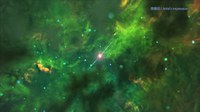 Long duration ɣ-ray bursts are associated with massive star explosions and are thus expected to reside in star-forming regions that contain molecular gas, the fuel for star formation. Previous searches for CO, a tracer of molecular gas, in burst host galaxies has not detected any emission. Molecules have been detected as absorption in the spectra of ɣ-ray burst afterglows, and the molecular gas is similar to the diffuse molecular clouds in the Milky Way. Absorption lines probe the interstellar medium only along the line-of-sight, so it is not clear whether the molecular gas represents the general properties of the regions where the bursts occur. Hatsukade et al. report spatially resolved ALMA observations of CO line emission and millimeter-wavelength continuum emission in two galaxies hosting ɣ-ray bursts. The bursts occurred in regions rich in dust, but not particularly rich in molecular gas. The ratio of molecular gas to dust is significantly lower than in star-forming regions in the Milky Way and nearby star-forming galaxies, suggesting that much of the dense gas where stars form has been dissipated by other massive stars.
Long duration ɣ-ray bursts are associated with massive star explosions and are thus expected to reside in star-forming regions that contain molecular gas, the fuel for star formation. Previous searches for CO, a tracer of molecular gas, in burst host galaxies has not detected any emission. Molecules have been detected as absorption in the spectra of ɣ-ray burst afterglows, and the molecular gas is similar to the diffuse molecular clouds in the Milky Way. Absorption lines probe the interstellar medium only along the line-of-sight, so it is not clear whether the molecular gas represents the general properties of the regions where the bursts occur. Hatsukade et al. report spatially resolved ALMA observations of CO line emission and millimeter-wavelength continuum emission in two galaxies hosting ɣ-ray bursts. The bursts occurred in regions rich in dust, but not particularly rich in molecular gas. The ratio of molecular gas to dust is significantly lower than in star-forming regions in the Milky Way and nearby star-forming galaxies, suggesting that much of the dense gas where stars form has been dissipated by other massive stars.
Figure: An artist’s conception of the environment around gamma ray burst GRB 020819B based on ALMA observations. Credit: NAOJ.
View Publication: Two ɣ-ray Bursts from Dusty Regions with Little Molecular Gas, B. Hatsukade (NAOJ), K. Ohta (Kyoto), A. Endo (Delft), K. Nakanishi (NAOJ), Y. Tamura (Tokyo), T. Hashimoto (NAOJ), and K. Kohno (Tokyo), 2014 Nature, 510, 247 (12 June 2014).
View 11 June 2014 Press Release
A Mid-life Crisis for SN 1970G
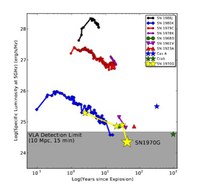 As the shock from a supernova (SN) expands, the mass-loss history we are able to probe is extended, providing insight to rapid timescale processes that govern the end states of massive stars. While SNe transition into remnants on timescales of decades to centuries, observations of this phase are currently limited. In this paper, Dittmann et al. present VLAobservations of SN 1970G, serendipitously observed during the monitoring campaign of SN 2011fe, which shares the same host galaxy. Utilizing the VLA and a deep Chandra X-ray exposure, the authors recover this middle-aged SN and resolve it from its associated H II cloud. They find that the flux density of SN 1970G has changed significantly since it was last observed: the X-ray luminosity has increased by ~3x, and the radio flux is significantly lower, just 27.5 μJy at 6.75 GHz, a level now detectable, given the recent VLA upgrade. These changes suggest that SN 1970G has entered a new stage of evolution toward an SN remnant, and we may be detecting the turn-on of the pulsar wind nebula. Deep radio observations of additional middle-aged SNe will provide a statistical census of the delicate transition period between SN and remnant.
As the shock from a supernova (SN) expands, the mass-loss history we are able to probe is extended, providing insight to rapid timescale processes that govern the end states of massive stars. While SNe transition into remnants on timescales of decades to centuries, observations of this phase are currently limited. In this paper, Dittmann et al. present VLAobservations of SN 1970G, serendipitously observed during the monitoring campaign of SN 2011fe, which shares the same host galaxy. Utilizing the VLA and a deep Chandra X-ray exposure, the authors recover this middle-aged SN and resolve it from its associated H II cloud. They find that the flux density of SN 1970G has changed significantly since it was last observed: the X-ray luminosity has increased by ~3x, and the radio flux is significantly lower, just 27.5 μJy at 6.75 GHz, a level now detectable, given the recent VLA upgrade. These changes suggest that SN 1970G has entered a new stage of evolution toward an SN remnant, and we may be detecting the turn-on of the pulsar wind nebula. Deep radio observations of additional middle-aged SNe will provide a statistical census of the delicate transition period between SN and remnant.
Figure: Radio light curves at 5 GHz of supernovae more than 25 years old. SN 1970G (yellow) is probing a new regime in the mass loss history of the end-of-life high mass stars, as well as probing the regime bridging supernovae (left) with supernova remnants (right).
View Publication: A Mid-life Crisis? Sudden Changes in Radio and X-Ray Emission from Supernova 1970G, J.A. Dittmann (CfA), A.M. Soderberg (CfA), L. Chomiuk (Michigan State), R. Margutti (CfA), W.M. Goss (NRAO), D. Milisavljevic (CfA), and R.A. Chevalier (Virginia), 2014 ApJ, 788, L38 (10 June 2014).
Mapping the Milky Way’s Sagittarius Spiral Arm
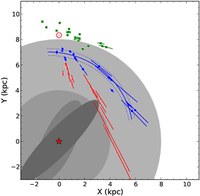 As part of the continuing Bar and Spiral Structure Legacy Survey (BeSSeL Survey) with the VLBA, Wu et al. report measurements of parallaxes and proper motions of ten high-mass star-forming regions in the Sagittarius spiral arm of the Milky Way. Combining these results with eight others from the literature, the authors investigated the structure and kinematics of the Sagittarius arm between Galactocentric azimuths β ≈ −2° and 65°. They find that the spiral pitch angle is 7.3° ± 1.5°; the arm’s half-width, defined as the rms deviation from the fitted spiral, is ≈0.2 kpc; and the nearest portion of the Sagittarius arm is 1.4 ± 0.2 kpc from the Sun. Unlike for adjacent spiral arms, the authors find no evidence for significant peculiar motions of sources in the Sagittarius arm opposite to Galactic rotation.
As part of the continuing Bar and Spiral Structure Legacy Survey (BeSSeL Survey) with the VLBA, Wu et al. report measurements of parallaxes and proper motions of ten high-mass star-forming regions in the Sagittarius spiral arm of the Milky Way. Combining these results with eight others from the literature, the authors investigated the structure and kinematics of the Sagittarius arm between Galactocentric azimuths β ≈ −2° and 65°. They find that the spiral pitch angle is 7.3° ± 1.5°; the arm’s half-width, defined as the rms deviation from the fitted spiral, is ≈0.2 kpc; and the nearest portion of the Sagittarius arm is 1.4 ± 0.2 kpc from the Sun. Unlike for adjacent spiral arms, the authors find no evidence for significant peculiar motions of sources in the Sagittarius arm opposite to Galactic rotation.
Figure: [Blue, Green, Red points] Locations of high-mass star formation regions in the Milky Way’s Sagittarius, local, and Scutum spiral arms, respectively, as determined by trigonometric parallaxes (with error bars). The red star is the Galactic Center.
View Publication: Trigonometric Parallaxes of Star-forming Regions in the Sagittarius Spiral Arm, Y. Wu (MPIfR), M. Sato (MPIfR), M.J. Reid (CfA), L. Moscadelli (INAF), B. Zhang (MPIfR), Y. Xu (Purple Mountain), A. Brunthaler (MPIfR), K.M. Menten (MPIfR), T.M. Dame (CfA), X.W. Zheng (Nanjing), 2014 A&A, 566, A17 (June 2014).
Probing Circumplanetary Disks
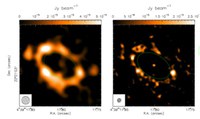 Isella et al. acquired VLA observations of the 7 mm continuum emission from the disk surrounding the young star LkCa 15 at an angular resolution of 70 mas that resolve the circumstellar emission on a spatial scale of 9 AU. The continuum emission traces a dusty annulus of 45 AU in radius that is consistent with the dust morphology observed at shorter wavelengths. The VLA observations also reveal a compact source at the center of the disk, possibly due to thermal emission from hot dust or ionized gas located within a few AU from the central star. No emission is observed between the star and the dusty ring and, in particular, at the position of the candidate protoplanet LkCa 15b. By comparing the observations with theoretical models for circumplanetary disk emission, the authors find that if LkCa 15b is a massive planet (> 5MJupiter ) accreting at a rate greater than 10–6 MJupiter yr–1, then its circumplanetary disk is less massive than 0.1MJupiter, or smaller than 0.4 Hill radii. Similar constraints are derived for any possible circumplanetary disk orbiting within 45 AU from the central star. The mass estimates are uncertain by at least one order of magnitude due to the mass opacity uncertainties. Future ALMA observations of this system might be able to detect circumplanetary disks down to a mass of 5 x 10–4 MJupiter and as small as 0.2 AU, providing crucial constraints on the presence of giant planets in the act of forming around this young star.
Isella et al. acquired VLA observations of the 7 mm continuum emission from the disk surrounding the young star LkCa 15 at an angular resolution of 70 mas that resolve the circumstellar emission on a spatial scale of 9 AU. The continuum emission traces a dusty annulus of 45 AU in radius that is consistent with the dust morphology observed at shorter wavelengths. The VLA observations also reveal a compact source at the center of the disk, possibly due to thermal emission from hot dust or ionized gas located within a few AU from the central star. No emission is observed between the star and the dusty ring and, in particular, at the position of the candidate protoplanet LkCa 15b. By comparing the observations with theoretical models for circumplanetary disk emission, the authors find that if LkCa 15b is a massive planet (> 5MJupiter ) accreting at a rate greater than 10–6 MJupiter yr–1, then its circumplanetary disk is less massive than 0.1MJupiter, or smaller than 0.4 Hill radii. Similar constraints are derived for any possible circumplanetary disk orbiting within 45 AU from the central star. The mass estimates are uncertain by at least one order of magnitude due to the mass opacity uncertainties. Future ALMA observations of this system might be able to detect circumplanetary disks down to a mass of 5 x 10–4 MJupiter and as small as 0.2 AU, providing crucial constraints on the presence of giant planets in the act of forming around this young star.
Figure: VLA 7mm imaging of the LkCa15 protoplanetary disk at 70 mas resolution and rms = 6 micro-Jy.
View Paper: Searching for Circumplanetary Disks Around LkCa 15, Andrea Isella (Caltech), Claire J. Chandler (NRAO), John M. Carpenter (Caltech), Laura M. Pérez (NRAO), and Luca Ricci (Caltech), 2014 ApJ, 788, 129 (20 June 2014).
Added 6 Feb 2015
The Discovery of a Gas-Rich Companion to an Extremely Metal-poor Galaxy
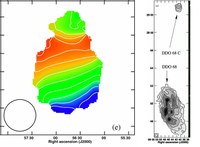 The galaxy DDO68 is a major outlier in the mass-metalicity relationship for galaxies, with a relatively large mass but such a low metallicity that it ranks it as one of the most metal-deficient galaxies know in the local volume, with a nebular oxygen abundance of only ~ 3% Z⊙. The origin of this extremely low oxygen abundance in DDO68 presents a challenge for models of the chemical evolution of galaxies. Cannon et al. have used archival VLAobservations, in combination with new GBT observations, to address this question and have discovered a gas rich dwarf companion to DDO68. The new GBT mapping data reveal a gaseous tidal bridge between these galaxies, possibly the source of the pristine gas that causes the low metallicity for DDO68.
The galaxy DDO68 is a major outlier in the mass-metalicity relationship for galaxies, with a relatively large mass but such a low metallicity that it ranks it as one of the most metal-deficient galaxies know in the local volume, with a nebular oxygen abundance of only ~ 3% Z⊙. The origin of this extremely low oxygen abundance in DDO68 presents a challenge for models of the chemical evolution of galaxies. Cannon et al. have used archival VLAobservations, in combination with new GBT observations, to address this question and have discovered a gas rich dwarf companion to DDO68. The new GBT mapping data reveal a gaseous tidal bridge between these galaxies, possibly the source of the pristine gas that causes the low metallicity for DDO68.
Figure: [Right] The VLA archival image of HI in DDO68 and its companion. [Left] The GBT image of the HI velocity in the tidal bridge connecting the galaxies.
View Publication: Discovery of a Gas-rich Companion to the Extremely Metal-poor Galaxy DDO 68, John M. Cannon (Macalester), Megan Johnson (ATNF), Kristen B.W. McQuinn (Minnesota), Erik D. Alfvin (Macalester), Jeremy Bailin (Alabama), H. Alyson Ford (NRAO), Léo GirardiINAF), Alec S. Hirschauer (Indiana), Steven Janowiecki (Indiana), John J. Salzer (Indiana), Angela Van Sistine (Indiana), Andrew Dolphin (Raytheon), E. C. Elson (Cape Town), Baerbel Koribalski (ATNF), Paola Marigo (Padova), Jessica L. Rosenberg (George Mason), Philip Rosenfield (Padova), Evan D. Skillman (Minnesota), Aparna Venkatesan (San Francisco), and Steven R. Warren (Maryland), 2014 ApJ Letters 787, L1 (20 May 2014).
Added 23 July 2014
Hot Stars Evaporating Disks in Orion
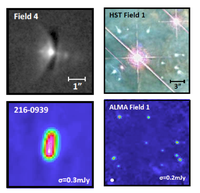 ALMA has imaged the sub-millimeter thermal continuum emission from a large sample of protoplanetary disks in Orion, known as proplyds, seen in Hubble Space Telescope (HST) images as dusty shadows or reflected light. ALMA detects most of these systems, with implied dust masses from 0.3 to 79 MJupiter. An anti-correlation is seen between regions of the most intense ultraviolet interstellar radiation field and the existence of massive proplyds disks, indicating the extreme impact O stars have on their local environments. These results suggest that a rapid dissipation of disk masses likely inhibits potential planet formation in the extreme-UV-dominated regions of OB associations.
ALMA has imaged the sub-millimeter thermal continuum emission from a large sample of protoplanetary disks in Orion, known as proplyds, seen in Hubble Space Telescope (HST) images as dusty shadows or reflected light. ALMA detects most of these systems, with implied dust masses from 0.3 to 79 MJupiter. An anti-correlation is seen between regions of the most intense ultraviolet interstellar radiation field and the existence of massive proplyds disks, indicating the extreme impact O stars have on their local environments. These results suggest that a rapid dissipation of disk masses likely inhibits potential planet formation in the extreme-UV-dominated regions of OB associations.
Figure: [Top] HST images from Bally et al. (2000, AJ, 119, 2919) of fields observed with ALMA in Cycle 0. [Bottom] Corresponding ALMA 856 μm observations. Each image is 20 x 20 arcsec.
View Publication: ALMA Observations of the Orion Proplyds, Rita K. Mann (NRC), James Di Francesco (NRC, Victoria), Doug Johnstone (NRC, Victoria, JAC), Sean M. Andrews (CfA), Jonathan P. Williams (IfA-Hawaii), John Bally (Colorado), Luca Ricci (Caltech), A. Meredith Hughes (Weslyan), and Brenda Matthews (NRC, Victoria), 2014 ApJ, 784, 82 (20 March 2014).
View 10 March 2014 Press Release
Added 2 May 2014
Mapping the Milky Way in Unprecedented Detail
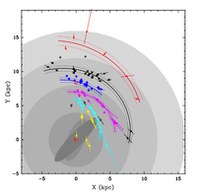 Over 100 trigonometric parallaxes and proper motions for masers associated with high-mass stars have been measured with the Bar and Spiral Structure Legacy Survey (BeSSeL) survey. This publication represents a major milestone in VLBA astrometry. These measurements provide strong evidence for the existence of spiral arms in the Milky Way, accurately locating many arm segments and yielding spiral pitch angles ranging from 7° to 20°. The widths of spiral arms increase with distance from the Galactic center. The distance to the Galactic center is 8.34 ± 0.16 kpc, and the circular rotation speed at the Sun is 240 ± 8 km/sec. The rotation curve is nearly flat between Galactocentric radii of ≈ 5 and 16 kpc, and the solar motion component in the direction of Galactic rotation is 14.6 ± 5.0 km/sec.
Over 100 trigonometric parallaxes and proper motions for masers associated with high-mass stars have been measured with the Bar and Spiral Structure Legacy Survey (BeSSeL) survey. This publication represents a major milestone in VLBA astrometry. These measurements provide strong evidence for the existence of spiral arms in the Milky Way, accurately locating many arm segments and yielding spiral pitch angles ranging from 7° to 20°. The widths of spiral arms increase with distance from the Galactic center. The distance to the Galactic center is 8.34 ± 0.16 kpc, and the circular rotation speed at the Sun is 240 ± 8 km/sec. The rotation curve is nearly flat between Galactocentric radii of ≈ 5 and 16 kpc, and the solar motion component in the direction of Galactic rotation is 14.6 ± 5.0 km/sec.
Figure: Plan view of the Milky Way showing the locations of high-mass star forming regions with trigonometric parallaxes measured by the VLBA, VLBI Exploration of Radio Astrometry (VERA), and the European VLBI Network (EVN).
View Publication: Trigonometric Parallaxes of High Mass Star Forming Regions: The Structure and Kinematics of the Milky Way,M.J. Reid (CfA), K.M. Menten (MPIfR), A. Brunthaler (MPIfR), X.W. Zheng (Nanjing), T.M. Dame (CfA), Y. Xu (Purple Mountain), Y. Wu (MPIfR), B. Zhang (MPIfR), A. Sanna (MPIfR), and M. Sato (MPIfR), 2014 ApJ, 783, 130 (10 March 2014).
Added 2 May 2014
Interstellar Medium Mass Evolution
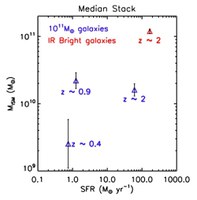 N. Scoville and his colleagues used ALMA submillimeter continuum observations to estimate the mass of the interstellar medium (dust + gas) in galaxies. The authors’ goal is an improved understanding of the physics of the cosmic star formation rate density (SFRD) evolution, which increases by 20-30x from the present to a peak at z ~ 2. Is this SFRD evolution driven by the availability of more gas, more efficient star formation? Such measurements are essential for modeling the gas consumption rate over cosmic time.
N. Scoville and his colleagues used ALMA submillimeter continuum observations to estimate the mass of the interstellar medium (dust + gas) in galaxies. The authors’ goal is an improved understanding of the physics of the cosmic star formation rate density (SFRD) evolution, which increases by 20-30x from the present to a peak at z ~ 2. Is this SFRD evolution driven by the availability of more gas, more efficient star formation? Such measurements are essential for modeling the gas consumption rate over cosmic time.
From their analysis of a sample of local star-forming galaxies, Planck observations of the Milky Way, and high-redshift submillimeter galaxies with CO detections, they find an empirical calibration between the 850 mm submillimeter dust continuum luminosity and the mass of the ISM. They argue that their technique of using continuum observations is superior to molecular line measurements of the ISM content due to the significantly shorter integration time required, less reliance on accurate redshifts, and the avoidance of excitation effects which can alter the CO luminosity-to-gas mass conversion factor. They apply their calibration to stacked images of mass-selected galaxies at redshifts of 0.4, 0.9 and 2, and they include an infrared-selected luminous galaxy sample at a redshift of 2 (see Figure). They find a factor of 6 decrease in the ISM content from redshifts of 0.9-2 (~14%) to redshift of 0.2 (2%) in the mass-selected sample, and a ~50% gas mass fraction for the z = 2 infrared galaxy sample.
View Publication: The Evolution of Interstellar Medium Mass Probed by Dust Emission: ALMA Observations at z = 0.3-2, N. Scoville (Caltech), H. Aussel (CEA-Saclay), K. Sheth (NRAO), K.S. Scott (NRAO), D. Sanders (IfA-Hawaii), R. Ivison (UKATC), A. Pope (Massachusetts), P. Capak (Spitzer), P. Vandden Bout (NRAO), S. Manohar (Caltech), J. Kartaltepe (NOAO), B. Robertson (Arizona), and S. Lilly (ETH Zurich), 2014 ApJ, 783, 84 (10 March 2014).
Added 2 May 2014
Cold Dust and Molecular Gas in Distant Starburst Galaxies/AGN
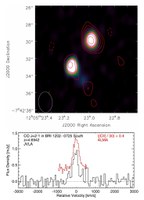 Wagg et al. used the VLA to image the CO 2-1 and cold dust emission in two distant, merging starburst/AGN at z ~ 4.5. The 8 GHz bandwidth of the VLA reveals (rest-frame) 250 GHz continuum emission for the first time, along with the cold molecular gas traced by CO 2-1. Spectral-energy-distribution fitting implies the dominant contribution to the rest frame 250 GHz continuum is thermal dust emission, while either thermal free-free or synchrotron emission contributes less than 30%. The cold dust masses exceeds 109 M☉, about 100 times that of the Milky Way.
Wagg et al. used the VLA to image the CO 2-1 and cold dust emission in two distant, merging starburst/AGN at z ~ 4.5. The 8 GHz bandwidth of the VLA reveals (rest-frame) 250 GHz continuum emission for the first time, along with the cold molecular gas traced by CO 2-1. Spectral-energy-distribution fitting implies the dominant contribution to the rest frame 250 GHz continuum is thermal dust emission, while either thermal free-free or synchrotron emission contributes less than 30%. The cold dust masses exceeds 109 M☉, about 100 times that of the Milky Way.
Figure: [TOP] Contours of the VLA 44 GHz continuum emission from BRI 1202−0725 overlaid on an image of the 340 GHz continuum emission observed with ALMA.
Figure: [BOTTOM] CO J = 2–1 line emission spectra for BRI 1202−0725 South compared with the continuum-subtracted [C ii] line profiles measured by ALMA. The continuum-subtracted [C ii] line emission has been scaled down and offset from zero for comparison with the CO.
View Publication: Karl G. Jansky Very Large Array Observations of Cold Dust and Molecular Gas in Starbursting Quasar Host Balaxies at z~4.5, J. Wagg (SKA, Cambridge, ESO), C.L. Carilli (NRAO, Cambridge), M. Aravena (ESO, Diego Portales), P. Cox (JAO), L. Lentati (Cambridge), R. Maiolino (Cambridge), R.G. McMahon (Cambridge), D. Riechers (Cornell), F. Walter (MPIfA), P. ANdreani (ESO), R. Hills (Cambridge), and A. Wolfe (UCSD), 2014 ApJ, 783, 71 (10 March 2014).
Added 2 May 2014
Disrupting comets in β Pic
 Protoplanetary disks of dusty debris around young stars are formed by collisions of asteroids, comets and dwarf planets. ALMA observations of the archetypal debris disk around β Pictoris show that 0.3% of a Moon mass of CO orbits in its debris belt. The gas distribution is highly asymmetric, with 30% found in a single clump 85 AU from the star, in a plane closely aligned with the orbit of the inner planet, β Pic b. CO will dissociate in 100 years so close to the star, implying active CO deposition in the disk. This gas clump likely delineates a region of enhanced cometary collisions, either from a mean motion resonance with an unseen giant planet, or from the remnants of a collision of icy Mars-mass planets.
Protoplanetary disks of dusty debris around young stars are formed by collisions of asteroids, comets and dwarf planets. ALMA observations of the archetypal debris disk around β Pictoris show that 0.3% of a Moon mass of CO orbits in its debris belt. The gas distribution is highly asymmetric, with 30% found in a single clump 85 AU from the star, in a plane closely aligned with the orbit of the inner planet, β Pic b. CO will dissociate in 100 years so close to the star, implying active CO deposition in the disk. This gas clump likely delineates a region of enhanced cometary collisions, either from a mean motion resonance with an unseen giant planet, or from the remnants of a collision of icy Mars-mass planets.
Figure: ALMA image of the observed β Pic dust continuum at 870 mm and the CO 3-2 emission at 346 GHz.
View Publication: Molecular Gas Clumps from the Destruction of Icy Bodies in the β Pictoris Debris Disk, W. R. F. Dent (JAO), M. C. Wyatt (Cambridge), A. Roberge (NASA-Goddard), J.-C. Augereau (Grenoble), S. Casassus (Univ de Chile), S. Corder (JAO), J. S. Greaves (St. Andrews), I. de Gregorio-Monsalvo (JAO, ESO), A. Hales (JAO), A. P. Jackson (Cambridge, Arizona State), A. Meredith Hughes (Weslyan), A.-M. Lagrange (Grenoble), B. Matthews (NRC, Victoria), and D. Wilner (SAO), 2014 Science, 343, 1490 (28 March 2014). Published online 6 March 2014.
View 6 March 2014 Press Release
Added 2 May 2014
Imaging the Cool ISM at z = 5.24
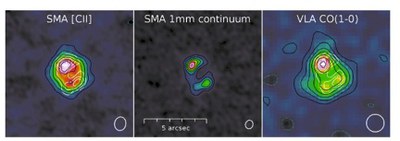 J091828.6+5142 is a strongly lensed starburst galaxy at z=5.24. Using lens magnification, and the high resolution of the VLA and the SMA, the cool gas (CO, [CII]), and dust has been imaged at sub-kiloparsec (kpc) resolution. The results show a complex system, including a late-stage (1 kpc separation) major gas rich merger, a high-velocity infalling galaxy, a lower star formation rate companion galaxy, and a possible molecular outflow seen in [NII] emission. These observations highlight the rich physical laboratories that are now accessible without lensing with ALMA at full sensitivity.
J091828.6+5142 is a strongly lensed starburst galaxy at z=5.24. Using lens magnification, and the high resolution of the VLA and the SMA, the cool gas (CO, [CII]), and dust has been imaged at sub-kiloparsec (kpc) resolution. The results show a complex system, including a late-stage (1 kpc separation) major gas rich merger, a high-velocity infalling galaxy, a lower star formation rate companion galaxy, and a possible molecular outflow seen in [NII] emission. These observations highlight the rich physical laboratories that are now accessible without lensing with ALMA at full sensitivity.
[Caption] Images of the Einstein ring galaxy J0918 at z=5.24.
View Publication: [C II] and 12CO(1-0) Emission Maps in HLSJ091828.6+514223: A Strongly Lensed Interacting System at z = 5.24, T. D. Rawle (ESAC, Arizona), E. Egami (Arizona), R. S. Bussmann (CfA), M. Gurwell (CfA), R. J. Ivison (Edinburgh), F. Boone (Toulouse), F. Combes (Paris), A. L. R. Danielson (Durham), M. Rex (Arizona), J. Richard (Lyon), I. Smail (Durham), A. M. Swinbank (Durham), B. Altieri (ESAC), A. W. Blain (Leicester), B. Clement (Arizona), M. Dessauges-Zavadsky (Geneve), A. C. Edge (Durham), G. G. Fazio (CfA), T. Jones (UC-Santa Barbara), J.-P. Kneib (Sauverny), A. Omont (Paris), P. G. Pérez-González (Arizona, Madrid), D. Schaerer (Geneve, CNRS), I. Valtchanov (ESAC), P. P. van der Werf (Leiden), G. Walth (Arizona), M. Zamojski (Geneve), and M. Zemcov (Caltech, JPL), 2014 ApJ, 783, 59 (1 March 2014).
Added 2 May 2014
Tracing Gas Accretion Onto Galaxies
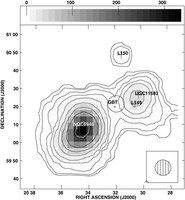 How galaxies obtain the gas to fuel star formation is a major question in modern astrophysics. Observations of ongoing neutral hydrogen (HI) accretion in nearby galaxies have only identified ~ 10% of the fuel necessary to sustain star formation in these galaxies. Known gas supplies will run out in a fraction of the Hubble time. Recently Pisano used the GBT to map the HI environment around NGC 2997 and NGC 6946. Around NGC 2997, the GBT data revealed an extended HI disk and all of its surrounding gas-rich satellite galaxies, but no filamentary features. The HI observations of NGC 6946 revealed a likely accreting HI stream. This stream may represent evidence for cold accretion in nearby galaxies, although a tidal remnant cannot be ruled out. The very high surface brightness sensitivity of the GBT (NHI ~ 1018 cm-2) was critical to obtaining this image of the inflowing cool gas.
How galaxies obtain the gas to fuel star formation is a major question in modern astrophysics. Observations of ongoing neutral hydrogen (HI) accretion in nearby galaxies have only identified ~ 10% of the fuel necessary to sustain star formation in these galaxies. Known gas supplies will run out in a fraction of the Hubble time. Recently Pisano used the GBT to map the HI environment around NGC 2997 and NGC 6946. Around NGC 2997, the GBT data revealed an extended HI disk and all of its surrounding gas-rich satellite galaxies, but no filamentary features. The HI observations of NGC 6946 revealed a likely accreting HI stream. This stream may represent evidence for cold accretion in nearby galaxies, although a tidal remnant cannot be ruled out. The very high surface brightness sensitivity of the GBT (NHI ~ 1018 cm-2) was critical to obtaining this image of the inflowing cool gas.
Figure: GBT total HI intensity map of NGC 6946, its companions, and putative HI filament. The GBT beam is shown in the lower right. The known galaxies are marked with plus signs.
View Publication: Green Bank Telescope Observations of Low Column Density H I around NGC 2997 and NGC 6946, D.J. Pisano (WVU), 2014 AJ, 147, 48 (March 2014).
Added 2 May 2014
Taking the Temperature of the Warm Neutral ISM and the Galactic Ly α Radiation Field
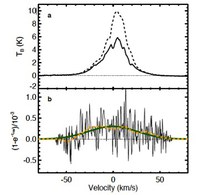 The temperature of the Warm Neutral Interstellar Medium (WNM) and the interstellar medium density of Ly α photons, are among the most important outstanding questions in Galactic astronomy. The stable passband of the VLA enables wide-line HI absorption measurements at t ~ 0.0001. Comparison to Arecibo emission measurements on larger scales implies a pervasive WNM with a temperature of 7200 ± 1800 K. This temperature lies above predictions based on collisional excitation alone, implying that Ly α scattering is more important in the ISM than previously assumed.
The temperature of the Warm Neutral Interstellar Medium (WNM) and the interstellar medium density of Ly α photons, are among the most important outstanding questions in Galactic astronomy. The stable passband of the VLA enables wide-line HI absorption measurements at t ~ 0.0001. Comparison to Arecibo emission measurements on larger scales implies a pervasive WNM with a temperature of 7200 ± 1800 K. This temperature lies above predictions based on collisional excitation alone, implying that Ly α scattering is more important in the ISM than previously assumed.
Figure: Mean HI 21cm Arecibo emission and VLA absorption profiles.
View Publication: Excitation Temperature of the Warm Neutral Medium as a New Probe of the Ly α Radiation Field, Claire E. Murray (Wisconsin), Robert R. Lindner (Wisconsin), Snežana Stanimirović (Wisconsin), W. M. Goss (NRAO), Carl Heiles (UC-Berkeley), John Dickey (Tasmania), Nickolas M. Pingel (Wisconsin), Allen Lawrence (Wisconsin), Jacob Jencson (NRAO, Ohio State), Brian L. Babler (Wisconsin), and Patrick Hennebelle (Paris-Saclay), 2014 ApJL, 781, L41 (1 February 2014).
Added 2 May 2014
Bi-static Radar Imaging of the Moon
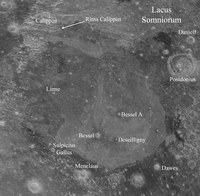 Bi-static radar imaging of central and northern Mare Serenitatis – conducted with the Arecibo Observatory transmitting and the GBT receiving – has improved our ability to discriminate our Moon’s volcanic complexes, tectonic features, and regolith properties. The Arecibo-GBT radar images acquired and described by Campbell et al. in their paper reveal flow-unit boundaries, channels, and lobes unseen via other remote sensing methods. Comparison of the 12.6 cm and 70 cm radar data implies a rough or block transition zone between the mare regolith and the intact bedrock, and an average regolith thickness of 10m, with a TiO2content of 2-3%. A localized pyroclastic deposit associated with Rima Calippus has been identified based on its low radar echo strength. A 250 km east-west trending feature in northern Mare Serenitatis suggests a large graben flooded by late-stage mare flows.
Bi-static radar imaging of central and northern Mare Serenitatis – conducted with the Arecibo Observatory transmitting and the GBT receiving – has improved our ability to discriminate our Moon’s volcanic complexes, tectonic features, and regolith properties. The Arecibo-GBT radar images acquired and described by Campbell et al. in their paper reveal flow-unit boundaries, channels, and lobes unseen via other remote sensing methods. Comparison of the 12.6 cm and 70 cm radar data implies a rough or block transition zone between the mare regolith and the intact bedrock, and an average regolith thickness of 10m, with a TiO2content of 2-3%. A localized pyroclastic deposit associated with Rima Calippus has been identified based on its low radar echo strength. A 250 km east-west trending feature in northern Mare Serenitatis suggests a large graben flooded by late-stage mare flows.
View Publication: Improved Discrimination of Volcanic Complexes, Tectonic Features, and Regolith Properties in Mare Serenitatis from Earth-based Radar Mapping, Bruce A. Campbell (Smithsonian), B. Ray Hawke (Hawaii-Manoa), Gareth A. Morgan (Smithsonian), Lynn M. Carter (NASA-Goddard), Donald B. Campbell (Cornell), and Michael Nolan (Arecibo), 2014 Journal of Geophysical Research: Planets, 119, 313 (February 2014).
View 14 May 2014 Press Release
Added 23 July 2014
Serendipitous Detection of a High-Redshift Luminous Galaxy
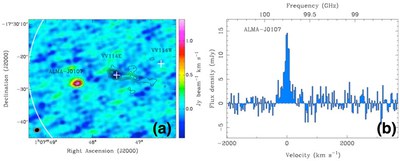 The sensitivity of ALMA opens up the possibility that many distant gas and dust-rich galaxies may be serendipitously detected in the fields of galactic or nearby extragalactic sources. Yoichi Tamura and his collaborators have made a detection of this type while analyzing recent observations of the nearby (z = 0.02) luminous infrared galaxy VV114. A single emission line from a background galaxy is detected at 99.75 GHz. The authors conclude, based on a photometric redshift analysis of the galaxy and both the observed frequency and the strength of the observed line, that the line is 12CO emission from a galaxy at a redshift of z = 2.467 or 3.622. Its derived molecular gas mass and far-infrared luminosities are calculated to be 8 x 1010 M⊙ and 1 x 1013 L⊙, respectively. While the derived star formation rate is high (~ 2000 M⊙/year) if all of the far-infrared luminosity is due to star formation, the galaxy contains a hard, luminous X-ray source that is suggestive of the presence of an AGN. The authors conclude the paper by estimating that a z > 1 galaxy with a similar CO flux to the background galaxy (> 1 Jy km/s) should be detected with the Full Science ALMA Band 3 every ~ 1000 pointings of a few minutes of more in integration time.
The sensitivity of ALMA opens up the possibility that many distant gas and dust-rich galaxies may be serendipitously detected in the fields of galactic or nearby extragalactic sources. Yoichi Tamura and his collaborators have made a detection of this type while analyzing recent observations of the nearby (z = 0.02) luminous infrared galaxy VV114. A single emission line from a background galaxy is detected at 99.75 GHz. The authors conclude, based on a photometric redshift analysis of the galaxy and both the observed frequency and the strength of the observed line, that the line is 12CO emission from a galaxy at a redshift of z = 2.467 or 3.622. Its derived molecular gas mass and far-infrared luminosities are calculated to be 8 x 1010 M⊙ and 1 x 1013 L⊙, respectively. While the derived star formation rate is high (~ 2000 M⊙/year) if all of the far-infrared luminosity is due to star formation, the galaxy contains a hard, luminous X-ray source that is suggestive of the presence of an AGN. The authors conclude the paper by estimating that a z > 1 galaxy with a similar CO flux to the background galaxy (> 1 Jy km/s) should be detected with the Full Science ALMA Band 3 every ~ 1000 pointings of a few minutes of more in integration time.
Figure: (a) An ALMA image of the CO emission from the serendipitously detected galaxy. Contours of 880µm emission are super-imposed. The plus symbols mark the positions of the near-infrared peaks associated with the foreground galaxy VV114. (b) An ALMA spectrum of the CO emission line.
View Publication: Serendipitous ALMA Detection of a Distant CO-emitting X-Ray Bright Galaxy, Yoichi Tamura (Tokyo), Toshiki Saito (NAOJ, Tokyo), Takeshi G. Tsuru (Kyoto), Hiroyuki Uchida (Kyoto), Daisuke Iono (NAOJ), Min S. Yun (Massachusetts), Daniel Espada (JAO), and Ryohei Kawabe (NAOJ, JAO), 2014 ApJL, 781, L39 (1 February 2014).
Added 2 May 2014
A Supernova Dust Factory
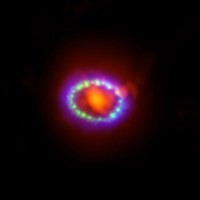 Supernova (SN) explosions are crucial engines driving the evolution of galaxies by shock heating gas, increasing the metallicity, creating dust, and accelerating energetic particles. In 2012, Indebetouw et al. used ALMA to observe SN 1987A, one of the best-observed supernovae, and acquire spatially resolved images at 450µm, 870µm, 1.4mm, and 2.8mm, an important transition wavelength range. The longer wavelength emission is dominated by synchrotron radiation from shock-accelerated particles; the shorter wavelength emission is from the largest mass of dust measured in a supernova remnant (>0.2 M☉). The authors show unambiguously, for the first time, that this dust has formed in the inner ejecta, the cold remnants of the exploded star's core. The dust emission is concentrated to the center of the remnant, so the dust has not yet been affected by the shocks. If a significant fraction survives, and if SN 1987A is typical, SNe are important cosmological dust producers.
Supernova (SN) explosions are crucial engines driving the evolution of galaxies by shock heating gas, increasing the metallicity, creating dust, and accelerating energetic particles. In 2012, Indebetouw et al. used ALMA to observe SN 1987A, one of the best-observed supernovae, and acquire spatially resolved images at 450µm, 870µm, 1.4mm, and 2.8mm, an important transition wavelength range. The longer wavelength emission is dominated by synchrotron radiation from shock-accelerated particles; the shorter wavelength emission is from the largest mass of dust measured in a supernova remnant (>0.2 M☉). The authors show unambiguously, for the first time, that this dust has formed in the inner ejecta, the cold remnants of the exploded star's core. The dust emission is concentrated to the center of the remnant, so the dust has not yet been affected by the shocks. If a significant fraction survives, and if SN 1987A is typical, SNe are important cosmological dust producers.
Figure: Composite image of SN 1987A. ALMA data (red) shows newly formed dust in the center of the remnant. HST (green) and Chandra (blue) show the expanding shockwave. Credit: R. Indebetouw et al., A. Angelich (NRAO/AUI/NSF); NASA/STScI/CfA/R. Kirshner; NASA/CXC/SAO/PSU/D. Burrows et al.
View Publication: Dust Production and Particle Acceleration in Supernova 1987A Revealed with ALMA, R. Indebetouw (UVA, NRAO), M. Matsuura (Univ College-London), E. Dwek (NASA-Goddard), G. Zanardo (ICRAR), M.J. Barlow (Univ College-London), M. Baes (Gent), P. Bouchet (CEA_Saclay), D.N. Burrows (PSU), R. Chevalier (UVA), G.C. Clayton (LSU), C. Fransson (Stockholm), B. Gaensler (CAASTRO, Sydney), R. Kirshner (CfA), et al., 2014 ApJL, 782, L2.
View 6 January 2014 Press Release
Added 21 Jan 2014
A Unique Gravitational Laboratory
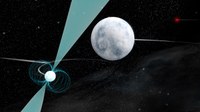 Gravitationally bound three-body systems show complex orbital interactions, which can constrain the compositions, masses and interior structures of the bodies and test theories of gravity, if sufficiently precise measurements are available. A triple system containing a radio pulsar could provide such measurements, but the only previously known such system, PSR B1620-26 – with a millisecond pulsar, a white dwarf, and a planetary-mass object in an orbit of several decades – shows only weak interactions. Ransom et al. report precision timing and multi-wavelength observations of PSR J0337+1715, the only known millisecond pulsar in a triple system, recently discovered as part of a large-scale pulsar survey with the GBT. Strong gravitational interactions are apparent and provide the masses of the pulsar the two white dwarf companions, as well as the inclinations of the orbits. The unexpectedly coplanar and nearly circular orbits indicate a complex and exotic evolutionary past that differs from those of known stellar systems. The gravitational field of the outer white dwarf strongly accelerates the inner binary containing the neutron star, and the system will thus provide an ideal laboratory to test the strong equivalence principle of General Relativity.
Gravitationally bound three-body systems show complex orbital interactions, which can constrain the compositions, masses and interior structures of the bodies and test theories of gravity, if sufficiently precise measurements are available. A triple system containing a radio pulsar could provide such measurements, but the only previously known such system, PSR B1620-26 – with a millisecond pulsar, a white dwarf, and a planetary-mass object in an orbit of several decades – shows only weak interactions. Ransom et al. report precision timing and multi-wavelength observations of PSR J0337+1715, the only known millisecond pulsar in a triple system, recently discovered as part of a large-scale pulsar survey with the GBT. Strong gravitational interactions are apparent and provide the masses of the pulsar the two white dwarf companions, as well as the inclinations of the orbits. The unexpectedly coplanar and nearly circular orbits indicate a complex and exotic evolutionary past that differs from those of known stellar systems. The gravitational field of the outer white dwarf strongly accelerates the inner binary containing the neutron star, and the system will thus provide an ideal laboratory to test the strong equivalence principle of General Relativity.
Figure: A millisecond pulsar (left foreground) is orbited by a hot white dwarf star (center), both of which are orbited by another, more distant and cooler white dwarf (top right). Credit: Bill Saxton; NRAO/AUI/NSF.
View Publication: A Milli-second pulsar in a Stellar Triple System, S.M. Ransom (NRAO), I.H. Stairs (UBC), A.M. Archibald (ASTRON, McGill), J.W.T. Hessles (ASTRON, Amsterdam), D.L. Kaplan (Wisconsin), M.H. van Kerkwijk (Toronto), J. Boyles (WVU, WKU), A.T. Deller (ASTRON), S. Chatterjee (Cornell), A. Schectman-Rook (Wisconsin-Madison), A. Berndsen (UBS), R.S. Lynch (McGill), D.R. Lorimer (WVU), C. Karako-Argaman (McGill), V.M. Kaspi (McGill), V.I. Kondratiev (ASTRON, Lebedev), M.A. McLaughlin (WVU), J. van Leeuwen (ASTRON, Amsterdam), R. Rosen (NRAO, WVU), M.S.E. Roberts (Eureka, NYU), and K. Stovall (UT-Brownsville, UNM), 2014 Nature, 505, 520 (23 January 2014).
View 5 January 2014 Press Release
Added 21 Jan 2014
A New Window on Dense Gas
 HCN and HCO+ trace the densest molecular clouds associated with active star formation. The new λ ~ 4mm detector system at the GBT was used by Kepley et al. to obtain high sensitivity HCN and HCO+ images of the dwarf starburst galaxy M82. The dense gas correlates with both recent star formation and more diffuse molecular gas, and has kinematics consistent with a rotating torus. The HCO+ also traces the outflow previously identified in CO. The central starburst region has a higher ratio of star formation to dense gas than the outer regions.
HCN and HCO+ trace the densest molecular clouds associated with active star formation. The new λ ~ 4mm detector system at the GBT was used by Kepley et al. to obtain high sensitivity HCN and HCO+ images of the dwarf starburst galaxy M82. The dense gas correlates with both recent star formation and more diffuse molecular gas, and has kinematics consistent with a rotating torus. The HCO+ also traces the outflow previously identified in CO. The central starburst region has a higher ratio of star formation to dense gas than the outer regions.
Figure: Images of M82: [Top] GBT image of HCN, [Center] GBT image of the HCO+, and [Bottom] VLA 3cm continuum.
View Publication: The Green Bank Telescope Maps the Dense, Star-forming Gas in the Nearby Starburst Galaxy M82, Amanda A. Kepley (NRAO), Adam K. Leroy (NRAO), David Frayer (NRAO), Antonion Usero (Observatorio Astronomico Nacional), Josh Marvil (New Mexico Tech, NRAO), and Fabian Walter (MPIfA), 2014 ApJ, 780, L13 (1 January 2014).
Probing the Inner Galaxy
 The pulsed radio emission from the Galactic Center (GC) magnetar SGR J1745-29 probes the turbulent, magnetized plasma of the GC hyperstrong scattering screen through both angular and temporal broadening. The angular size of SGR J1745-29 was obtained with the VLBAand VLA at 8.7 and 15.4 GHz. The source sizes are consistent with the scatter-broadened size of Sgr A*, demonstrating that SGR J1745-29 is also located behind the same hyperstrong scattering medium. The distance to the screen is 5.9 ± 0.3 kpc, consistent with being located in the Scutum spiral arm. This is a substantial revision of the previously held model in which the scattering screen is located very close to the GC. This result provides promise for pulsar searches at the GC at 10GHz.
The pulsed radio emission from the Galactic Center (GC) magnetar SGR J1745-29 probes the turbulent, magnetized plasma of the GC hyperstrong scattering screen through both angular and temporal broadening. The angular size of SGR J1745-29 was obtained with the VLBAand VLA at 8.7 and 15.4 GHz. The source sizes are consistent with the scatter-broadened size of Sgr A*, demonstrating that SGR J1745-29 is also located behind the same hyperstrong scattering medium. The distance to the screen is 5.9 ± 0.3 kpc, consistent with being located in the Scutum spiral arm. This is a substantial revision of the previously held model in which the scattering screen is located very close to the GC. This result provides promise for pulsar searches at the GC at 10GHz.
Figure: VLBI mages of J1745-29 at 8 and 15GHz.
View Publication: The Angular Broadening of the Galactic Center Pulsar SGR J1745-29: A New Constraint on the Scattering Medium, Geoffrey C. Bower (Berkeley), Adam Deller (ASTRON), Paul Demorest (NRAO), Andreas Brunthaler (MPIfR), Ralph Eatough (MPIfR), Heino Falcke (ASTRON, MPIfR, Radboud), Michael Kramer (MPIfR), K.J. Lee (MPIfR), and Laura Spitler (MPIfR), 2014 ApJL,780, L2, (1 January 2014).
Added 21 Jan 2014
Binaries Formed via Disk Fragmentation
 Tobin et al. present observations of Class 0/I protostars acquired with the VLA and observations the Combined Array for Research in Millimeter-wave Astronomy (CARMA). They find that L1165-SMM1 and CB230 IRS1 have probable binary companions at separations of ∼100 AU from detections of secondary peaks at multiple wavelengths. The position angles of these companions are nearly orthogonal to the direction of the observed bipolar outflows, consistent with the expected protostellar disk orientations. They suggest that these companions may have formed from disk fragmentation; turbulent fragmentation would not preferentially arrange the binary companions to be orthogonal to the outflow direction. For L1165-SMM1, the 7.3 mm and 1.3 mm emission show evidence of a large (R >100 AU) disk. For the L1165-SMM1 primary protostar and the CB230 IRS1 secondary protostar, the 7.3mm emission is resolved into structures consistent with ∼20 AU radius disks. For the other protostars, including L1157-mm, the emission is unresolved, suggesting disks with radii < 20 AU.
Tobin et al. present observations of Class 0/I protostars acquired with the VLA and observations the Combined Array for Research in Millimeter-wave Astronomy (CARMA). They find that L1165-SMM1 and CB230 IRS1 have probable binary companions at separations of ∼100 AU from detections of secondary peaks at multiple wavelengths. The position angles of these companions are nearly orthogonal to the direction of the observed bipolar outflows, consistent with the expected protostellar disk orientations. They suggest that these companions may have formed from disk fragmentation; turbulent fragmentation would not preferentially arrange the binary companions to be orthogonal to the outflow direction. For L1165-SMM1, the 7.3 mm and 1.3 mm emission show evidence of a large (R >100 AU) disk. For the L1165-SMM1 primary protostar and the CB230 IRS1 secondary protostar, the 7.3mm emission is resolved into structures consistent with ∼20 AU radius disks. For the other protostars, including L1157-mm, the emission is unresolved, suggesting disks with radii < 20 AU.
Figure: Radio images of the L1165-SMM1 binary protostellar system. Protostar locations are marked with crosses; they are separated by ~ 100 AU. [Left panel] The shorter wavelength data (1.3 mm/230 GHz) taken with CARMA. [Middle, Right panels] The longer wavelength data (7.3 mm/41 GHz). The left and middle panels have comparable resolutions of 0.33" or 100 AU; the right panel has 0.1" (30 AU) resolution. For comparison, the orbit of Pluto around the sun has a semi-major axis of 39 AU. The blue and red arrows denote the directions of the outflowing gas from the protostars.
View publication: VLA and CARMA Observations of Protostars in the Cepheus Clouds: Sub-arcsecond Proto-Binaries Formed via Disk Fragmentation, John J. Tobin (NRAO), Claire J. Chandler (NRAO), David J. Wilner (CfA), Leslie W. Looney (Illinois), Laurent Loinard (UNAM), Hsin-Fang Chiang (Hawaii), Lee Hartmann (Michigan), Nuria Calvet (Michigan), Paolo D’Alesso (UNAM), Tyler L. Bourke (CfA), and Woojin Kwon (SRON), 2014, accepted ApJ.
View 31 December 2013 Press Release
Added 21 Jan 2014
The Dynamics of Massive Starless Cores
 Intermediate- and high-mass stars may be born from relatively massive pre-stellar gas cores. The turbulent core accretion model invokes such cores as being in approximate virial equilibrium and in approximate pressure equilibrium with their surrounding clump medium. Alternatively, the competitive accretion model requires strongly sub-virial initial conditions that then lead to extensive fragmentation to the thermal Jeans scale, with intermediate- and high-mass stars forming later by competitive accretion. To test these models, Tan et al. have identified four massive (~100 M☉) clumps from mid-infrared extinction mapping of infrared dark clouds. They present ALMA observations of these four clumps that probe the N2D+ (3–2) line at 2.3 arcsecond resolution, find six N2D+ cores, and determine their dynamical state. The observed velocity dispersions and sizes are broadly consistent with the predictions of the turbulent core model of self-gravitating, magnetized, and virialized cores that are bounded by the high pressures of their surrounding clumps. However, in the most massive cores, their results suggest that moderately enhanced magnetic fields may be needed for the structures to be in virial and pressure equilibrium. Magnetically regulated core formation may thus be important in controlling the formation of massive cores, inhibiting their fragmentation, and thus helping to establish the stellar IMF.
Intermediate- and high-mass stars may be born from relatively massive pre-stellar gas cores. The turbulent core accretion model invokes such cores as being in approximate virial equilibrium and in approximate pressure equilibrium with their surrounding clump medium. Alternatively, the competitive accretion model requires strongly sub-virial initial conditions that then lead to extensive fragmentation to the thermal Jeans scale, with intermediate- and high-mass stars forming later by competitive accretion. To test these models, Tan et al. have identified four massive (~100 M☉) clumps from mid-infrared extinction mapping of infrared dark clouds. They present ALMA observations of these four clumps that probe the N2D+ (3–2) line at 2.3 arcsecond resolution, find six N2D+ cores, and determine their dynamical state. The observed velocity dispersions and sizes are broadly consistent with the predictions of the turbulent core model of self-gravitating, magnetized, and virialized cores that are bounded by the high pressures of their surrounding clumps. However, in the most massive cores, their results suggest that moderately enhanced magnetic fields may be needed for the structures to be in virial and pressure equilibrium. Magnetically regulated core formation may thus be important in controlling the formation of massive cores, inhibiting their fragmentation, and thus helping to establish the stellar IMF.
Figure: ALMA data overlaid on an artist’s impression background. The ALMA data show two main cores as imaged by N2D+ emission. The core on the right is particularly bright and rounded, suggesting it is self-gravitating and poised to form a massive, single star. The other core appears more distorted and fragmented, potentially leading to the formation of multiple lower-mass stars.Credit: Bill Saxton & Alexandra Angelich (NRAO/AUI/NSF); ALMA (ESO/NAOJ/NRAO).
View Publication: The Dynamics of Massive Starless Cores with ALMA, Jonathan C. Tan (Florida), Shuo Kong (Florida), Michael J. Butler (Florida), Paola Caselli (Leeds), and Francesco Fontani (INAF), 2014 ApJ, 779, 96.
View 20 December 2013 Press Release
Added 21 Jan 2014
Sub-mm Galaxies in the Extended Chandra Deep Field South
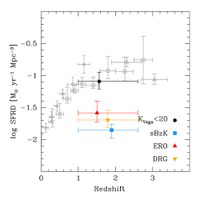 In a recent 344 GHz continuum ALMA Cycle 0 study, Roberto Decarli and his collaborators performed a stacking analysis of four classes of high-redshift galaxies selected based on optical and near-IR fluxes: the K-selected galaxies, star-forming sBzK galaxies, extremely red objects (EROs) and distant red galaxies (DOGs). These galaxies classes represent different criteria that were used to select star-forming galaxies prior to the advent of deep infrared – i.e., Spitzer and Herschel – datasets.
In a recent 344 GHz continuum ALMA Cycle 0 study, Roberto Decarli and his collaborators performed a stacking analysis of four classes of high-redshift galaxies selected based on optical and near-IR fluxes: the K-selected galaxies, star-forming sBzK galaxies, extremely red objects (EROs) and distant red galaxies (DOGs). These galaxies classes represent different criteria that were used to select star-forming galaxies prior to the advent of deep infrared – i.e., Spitzer and Herschel – datasets.
In the stacked images, each class is detected at the 10σ level. Herschel Spectral and Photometric Imaging Receiver (SPIRE) data are combined with the stacked datasets in order to assess the spectral energy distribution (SED) of these galaxies. The infrared SED components are well fit by a modified blackbody with a β = 1.6 and a dust temperature of 30K. The derived infrared luminosities are in the range 0.5-1.1x1012L⊙, which corresponds to star formation rates of 75 - 140M⊙ per year.
Finally, the authors place their analysis in the broader cosmological context by deriving star formation rate densities (SFRDs): the K-selected galaxies have SFRDs over the redshift range z =1 - 2.6 consistent with prior studies of rest-frame UV and 24µm selected galaxies which make use of infrared and radio data to estimate star formation rates. In contrast, the color-selected galaxy classes (sBzK, EROs, and DOGs) have SFRDs that are lower by a factor of three over the same redshift range.
Figure: The Cosmic Star Formation Rate Density as a function of redshift. The unfilled symbols represent UV and mid-IR selected galaxies from prior studies of the SFRDs. The filled symbols are from Decarli et al.
View Publication: An ALMA Survey of Sub-millimeter Galaxies in the Extended Chandra Deep Field South: Sub-millimeter Properties of Color-selected Galaxies, R. Decarli (MPIfA), I. Smail (Durham), F. Walter (MPIfA), A.M. Swinbank (Durham), S. Chapman (Cambridge, Dalhousie), K.E.K. Coppin (Hertfordshire), H. Dannerbauer (Wien), T.R. Greve (London), J.A. Hodge (MPIfA), R. Ivison (Edinburgh), A. Karim (Durham, Bonn), K.K. Knudsen (Chalmers), L. Lindroos (Chalmers), H.-W. Rix (MPIfA), E. Schinnerer (MPIfA), J.M. Simpson (Durham), P. van der Werf (Leiden), and A. Weiss (MPIfR), 2014 ApJ, 780, 115 (20 December 2013).
Added 2 May 2014
Imaging the Cosmic Web
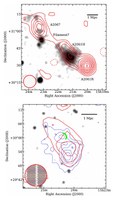 Farnsworth et al. present results from a study of 12 X-ray bright clusters that they observed at 1.4 GHz with the GBT. Their observations achieved a median (best) 1s rms sensitivity of 0.01 (0.006) μJy arcsec-2and found a significant excess of diffuse, low surface brightness emission in 11 of the 12 Abell clusters, including a 2 Megaparsec radio halo in a minor-merger candidate cluster. These results imply radio halos are larger and brighter than previously thought.
Farnsworth et al. present results from a study of 12 X-ray bright clusters that they observed at 1.4 GHz with the GBT. Their observations achieved a median (best) 1s rms sensitivity of 0.01 (0.006) μJy arcsec-2and found a significant excess of diffuse, low surface brightness emission in 11 of the 12 Abell clusters, including a 2 Megaparsec radio halo in a minor-merger candidate cluster. These results imply radio halos are larger and brighter than previously thought.
Figure: The Megaparsec-scale radio emission observed in Abell 2069 and Abell 2067 with the GBT. Red contours are radio data; grey contours are X-ray data. The GBT beam is at lower left in each figure.
View Publication: Discovery of Megaparsec-scale, Low Surface Brightness Emission in Clusters of Galaxies using the GBT, Damon Farnsworth (Minnesota), Lawrence Rudnick (Minnesota), Shea Brown (Iowa), and Gianfranco Brunetti (Bologna), 2013 ApJ, 779, 189 (20 December 2013).
Added 2 May 2014
Detailed Imaging of the Sombrero Galaxy Jet
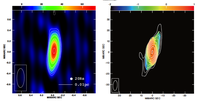 The Sombrero galaxy (M 104) is associated with one of the nearest low-luminosity active galactic nuclei (AGN). Hada et al. have imaged the radio jet structure of this AGN between 1.4 and 43GHz using the VLBA down to scales of 0.01pc, or 100 RSchwarzschild. The jet is found to be within 25o of the Earth line-of-sight. The derived pole-on nature of the M 104 jet is in accordance with previous arguments that M 104 contains a true type II AGN, i.e., the broad line region of this nucleus is actually absent or intrinsically weak.
The Sombrero galaxy (M 104) is associated with one of the nearest low-luminosity active galactic nuclei (AGN). Hada et al. have imaged the radio jet structure of this AGN between 1.4 and 43GHz using the VLBA down to scales of 0.01pc, or 100 RSchwarzschild. The jet is found to be within 25o of the Earth line-of-sight. The derived pole-on nature of the M 104 jet is in accordance with previous arguments that M 104 contains a true type II AGN, i.e., the broad line region of this nucleus is actually absent or intrinsically weak.
Figure: The VLBA 43GHz image of M104 at 0.2 mas resolution (left), and the spectral index image (right).
View Publication: Evidence for a Nuclear Radio Jet and its Structure Down to <100 Schwarzschild Radii in the Center of the Sombrero Galaxy (M 104, NGC 4594), Kazuhiro Hada (INAF, NAOJ, Akhiro Doi (JAXA), Hiroshi Nagai (NAOJ), Makoto Inoue (ASIAA), Mreki Honma (NAOJ, SOKENDAI), Marcello Giroletti (INAF), and Gabriele Giovannini (INAF, Bologna), 2013 ApJ, 779, 6 (15 Nov 2013).
Added 17 Jan 2014
The Coldest Place in the Universe
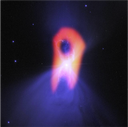 The pre-planetary nebula, the Boomerang Nebula, is the coldest known place in the Universe, refrigerated by an expanding molecular outflow (Joule-Thomson effect), to roughly 1deg K. Planetary nebula correspond to the dying moments of Solar-analog stars, the transition from the Asymptotic Giant Branch to a planetary nebula. An HST image shows a classic double-lobed hourglass shape with a very narrow central region, expected for expanding gas outflows. ALMA CO observations show the inner double structure, but also a more spherical, high velocity outflow on large scales, and a central dust-lane of millimeter-sized grains. The HST image is most likely the result of illumination of the cold outflow material.
The pre-planetary nebula, the Boomerang Nebula, is the coldest known place in the Universe, refrigerated by an expanding molecular outflow (Joule-Thomson effect), to roughly 1deg K. Planetary nebula correspond to the dying moments of Solar-analog stars, the transition from the Asymptotic Giant Branch to a planetary nebula. An HST image shows a classic double-lobed hourglass shape with a very narrow central region, expected for expanding gas outflows. ALMA CO observations show the inner double structure, but also a more spherical, high velocity outflow on large scales, and a central dust-lane of millimeter-sized grains. The HST image is most likely the result of illumination of the cold outflow material.
Figure: The Boomerang Nebula imaged with ALMA and HST. [Blue] HST shows a classic double-lobe shape with a very narrow central region. ALMA shows a more extended CO distribution, plus a narrow dust lane in the center (Sahai ea).
View Publication: ALMA Observations of the Coldest Place in the Universe: The Boomerang Nebula, R. Sahai (JPL), W.H.T. Vlemmings (Onsala), P.J. Huggins (NYU), L.-Å Nyman (JAO, ESO), and I. Gonidakis (CSIRO), 2013 ApJ, 777, 92 (10 Nov 2013).
View 24 Oct 2013 Press Release
Added 17 Jan 2014
A Magnetized Pulsar near the Galactic Center
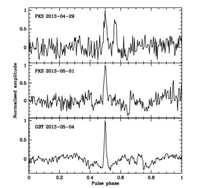 The center of our Galaxy hosts a supermassive black hole, Sgr A*. Young, massive stars within 0.5 pc of Sgr A* are evidence of an episode of intense star formation near the black hole a few million years ago, which may have left behind a young neutron star traveling deep into Sgr A*’s gravitational potential. On 2013 April 25, a short X-ray burst was observed in the direction of the Galactic Center. Via observations with Chandra and Swift satellites, the associated magnetar was located and its spin period and derivative were refined. Quasi-simultaneous observations with the Parkes Radio Telescope and the GBT confirmed the existence of this pulsing magnetar at an angular distance of 2.4 ± 0.3 arcsec ≈ 0.07 - 2 pc from Sgr A* and determined a dispersion measure (DM) of 1750 pc cm-3, the highest ever observed for a radio pulsar. The magnetar is likely (~90% probability) in a bound orbit around the black hole.
The center of our Galaxy hosts a supermassive black hole, Sgr A*. Young, massive stars within 0.5 pc of Sgr A* are evidence of an episode of intense star formation near the black hole a few million years ago, which may have left behind a young neutron star traveling deep into Sgr A*’s gravitational potential. On 2013 April 25, a short X-ray burst was observed in the direction of the Galactic Center. Via observations with Chandra and Swift satellites, the associated magnetar was located and its spin period and derivative were refined. Quasi-simultaneous observations with the Parkes Radio Telescope and the GBT confirmed the existence of this pulsing magnetar at an angular distance of 2.4 ± 0.3 arcsec ≈ 0.07 - 2 pc from Sgr A* and determined a dispersion measure (DM) of 1750 pc cm-3, the highest ever observed for a radio pulsar. The magnetar is likely (~90% probability) in a bound orbit around the black hole.
Figure: Pulse profiles of the three radio observations where the magnetar was detected.
View Publication: A Strongly Magnetized Pulsar within the Grasp of the Milky Way’s Supermassive Black Hole, N. Rea (CSIC-IEEC), P. Espisito (INAF-IASF), J.A. Pons (d’Alacant), R. Turolla (d’Alacant, MSSL-UCL), D.F. Torres (CSIC-IEEC, ICREA), G.L. Israel (INAF-OAR), A. Possenti (INAF-OAC), M. Burgay (INAF-OAC), D. Viganò (d’Alacant), A. Papitto (CSIC-IEEC), R. Perna (JILA) et al., 2013 ApJL, 775, L34 (1 October 2013).
Added 17 Jan 2014
Molecular Gas Dynamics in a Nearby AGN/Starburst
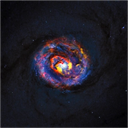 The Seyfert 2 galaxy NGC 1433 was imaged with ALMA in CO 3-2 at the unprecedented spatial resolution of 0.5 arcseconds (24 pc), probing the active galactic nucleus (AGN) feeding and feedback phenomena through the morphology and dynamics of the gas inside the central kpc. ALMA reveals a nuclear bar of 400 pc radius embedded in the large-scale primary bar. The CO map also reveals a nuclear gaseous spiral structure inside the nuclear ring encircling the nuclear stellar bar. Most of the gas shows ordered rotation, although a strong (200 km/s, 7 M⊙/yr) outflow is seen in the nucleus, likely driven by the inner radio jets, possibly boosted by star formation.
The Seyfert 2 galaxy NGC 1433 was imaged with ALMA in CO 3-2 at the unprecedented spatial resolution of 0.5 arcseconds (24 pc), probing the active galactic nucleus (AGN) feeding and feedback phenomena through the morphology and dynamics of the gas inside the central kpc. ALMA reveals a nuclear bar of 400 pc radius embedded in the large-scale primary bar. The CO map also reveals a nuclear gaseous spiral structure inside the nuclear ring encircling the nuclear stellar bar. Most of the gas shows ordered rotation, although a strong (200 km/s, 7 M⊙/yr) outflow is seen in the nucleus, likely driven by the inner radio jets, possibly boosted by star formation.
Figure: A composite ALMA - HST image of the central parts of the nearby active galaxy NGC 1433. The faint blue background image shows the central dust lanes of this galaxy (HST). The red structures are the dust and molecular gas imaged by ALMA.
View Publication: ALMA observations of feeding and feedback in nearby Seyfert galaxies: an AGN-driven outflow in NGC 1433,F. Combes (Paris), S. García-Burillo (Madrid), V. Casasola (INAF Bologna), L. Hunt (INAF Firenzi), M. Krips (IRAM), A.J. Baker (Rutgers), A. Eckhart (F. Boone (CNRS), A. Eckart (Köln), I. Marquez (Andalucia), R. Neri (IRAM), E. Schinnerer (MPIfA), and L.J. Tacconi (MPIfeP), 2013 A&A, 558, 124 (October 2013).
Added 17 Jan 2014
“Pillars of Creation” in 30 Doradus/Large Magellanic Cloud
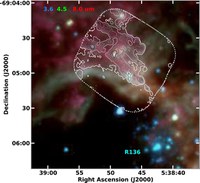 Indebetouw et al. present ALMA observations of 30 Doradus and the highest resolution view of molecular gas in an extragalactic star formation region to date (~0.4 pc × 0.6 pc). The 30Dor-10 cloud north of R136 was mapped in 12CO 2–1, 13CO 2–1, C18O 2–1, 1.3 mm continuum, the H30α recombination line, and two H2CO 3–2 transitions. 12CO emission is associated with small filaments and clumps (0.1pc, 103 M⊙), including protostars and “pillars of creation” photoablated by intense radiation from R136. Clumps in 30 Dor follow trends in size, line width, and surface density similar to massive clumps in the Milky Way. The consistency of clump masses calculated from dust continuum, CO, and the virial theorem reveals that the CO abundance in 30 Doradus clumps is not significantly different from the Large Magellanic Cloud average, but the dust abundance may be reduced by ~2x.
Indebetouw et al. present ALMA observations of 30 Doradus and the highest resolution view of molecular gas in an extragalactic star formation region to date (~0.4 pc × 0.6 pc). The 30Dor-10 cloud north of R136 was mapped in 12CO 2–1, 13CO 2–1, C18O 2–1, 1.3 mm continuum, the H30α recombination line, and two H2CO 3–2 transitions. 12CO emission is associated with small filaments and clumps (0.1pc, 103 M⊙), including protostars and “pillars of creation” photoablated by intense radiation from R136. Clumps in 30 Dor follow trends in size, line width, and surface density similar to massive clumps in the Milky Way. The consistency of clump masses calculated from dust continuum, CO, and the virial theorem reveals that the CO abundance in 30 Doradus clumps is not significantly different from the Large Magellanic Cloud average, but the dust abundance may be reduced by ~2x.
Figure: ALMA CO 2-1 contours plus Spitzer multi-color imaging (Red, green, blue: 7.9, 5.8, 3.6 μm, respectively) of 30 Dor.R136 is the blue cluster located south of the ALMA field of view.
View Publication: ALMA Resolves 30 Doradus: Sub-parsec Molecular Cloud Structure near the Closest Super Star Cluster,Remy Indebetouw (NRAO, Virginia), Crystal Brogan (NRAO), C.-H. Rosie Chen (MPIfR), Adam Leroy (NRAO), Kelsey Johnson (Virginia), Erik Muller (NAOJ), Suzanne Madden (Saclay), Diane Cormier (Heidelberg), Frederic Galliano (Saclay), Annie Hughes (MPIfA), Todd Hunter (NRAO), Akiko Kawamura (NAOJ), Amanda Kepley (NRAO), Vianney Lebouteiller (Saclay), Margaret Meixner (STScI), Joana M. Oliveira (Keele), Toshikazu Onishi (Osaka), and Tatiana Vasyunina (Virginia), 2013 ApJ, 774, 73 (1 Sep 2013).
Added 17 Jan 2014
Imaging Large Scale HI structure
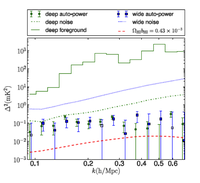 The large-scale distribution of neutral hydrogen in the Universe will be luminous through its 21 cm emission. Switzer et al. use data acquired with the GBT that span the redshift range 0.6 < z < 1.0 to detect, for the first time, the auto-power spectrum of 21 cm intensity fluctuations and constrain neutral hydrogen fluctuations at z ∼ 0.8. The synchrotron foregrounds exceed the signal by 103, but have fewer degrees of freedom and can be removed efficiently. Through a Bayesian treatment of signal and foregrounds, they derive an HI baryon density ΩHI bHI= [0.62+0.23-0.15] × 10-3 at 68 per cent confidence, where ΩHI is the neutral hydrogen (H I) fraction of the cosmic closure density, and bHI is the H I bias parameter.
The large-scale distribution of neutral hydrogen in the Universe will be luminous through its 21 cm emission. Switzer et al. use data acquired with the GBT that span the redshift range 0.6 < z < 1.0 to detect, for the first time, the auto-power spectrum of 21 cm intensity fluctuations and constrain neutral hydrogen fluctuations at z ∼ 0.8. The synchrotron foregrounds exceed the signal by 103, but have fewer degrees of freedom and can be removed efficiently. Through a Bayesian treatment of signal and foregrounds, they derive an HI baryon density ΩHI bHI= [0.62+0.23-0.15] × 10-3 at 68 per cent confidence, where ΩHI is the neutral hydrogen (H I) fraction of the cosmic closure density, and bHI is the H I bias parameter.
View Publication: Determination of z ~ 0.8 Neutral Hydrogen Fluctuations Using the 21 cm Intensity Mapping Autocorrelation, E.R. Switzer (CITA), K.W. Masui (CITA, Toronto), K. Bandura (McGill), L.-M. Calin (CITA), T.-C. Chang (ASIAA), X.-L. Chen (NAO-CAS, Peking), Y.-C. Li (NAO-CAS), Y.-W. Liao (ASIAA), A. Natarajan (Carnegie Mellon), U.-L. Pen (CITA), J.B. Peterson (Carnegie Mellon), J.R. Shaw (CITA), and T.C. Voytek (Carnegie Mellon), 2013 MNRAS, 434, L46 (1 September 2013).
Added 21 Jan 2014
Measuring the Hubble Constant
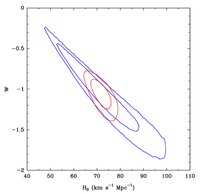 A new geometric maser distance has been estimated to the active galaxy NGC 4258 from 18 epochs of Very Long Baseline Interferometry observations, and 10 years monitoring the velocities of the 22 GHz masers in NGC 4258, including GBT and VLA. A new model includes both disk warping and confocal elliptical maser orbits with differential precession. The distance to NGC 4258 is determined to be 7.60 ± 0.17 ± 0.15 Mpc, a 3% uncertainty including formal fitting and systematic terms. The resulting Hubble Constant, based on the use of the Cepheid variables in NGC 4258 to recalibrate the Cepheid distance scale, is H0 = 72.0 ± 3.0 km s-1 Mpc-1.
A new geometric maser distance has been estimated to the active galaxy NGC 4258 from 18 epochs of Very Long Baseline Interferometry observations, and 10 years monitoring the velocities of the 22 GHz masers in NGC 4258, including GBT and VLA. A new model includes both disk warping and confocal elliptical maser orbits with differential precession. The distance to NGC 4258 is determined to be 7.60 ± 0.17 ± 0.15 Mpc, a 3% uncertainty including formal fitting and systematic terms. The resulting Hubble Constant, based on the use of the Cepheid variables in NGC 4258 to recalibrate the Cepheid distance scale, is H0 = 72.0 ± 3.0 km s-1 Mpc-1.
Figure: Covariance plot of Ho and w from the NGC 4258 maser observations.
View Publication: Toward a New Geometric Distance to the Active Galaxy NGC 4258. III. Final Results and the Hubble Constant, Liz Humphreys (ESO, CfA), Mark Reid (CfA), Jim Moran (CfA), Lincoln Greenhill (CfA), and Alice Argon (CfA), 2013 ApJ, 775, 13 (1 September 2013).
Added 21 Jan 2014
View Highlights from previous years: FY2013 | FY2012 | FY2011

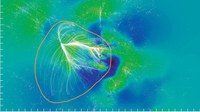

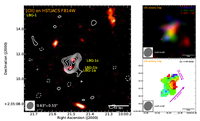




Connect with NRAO